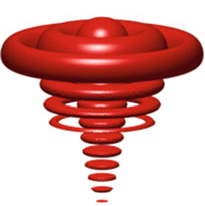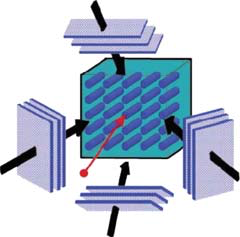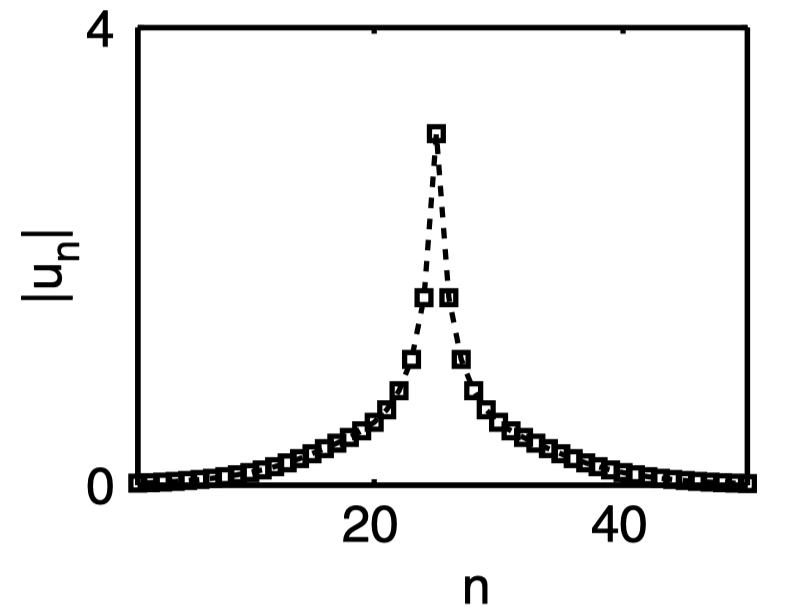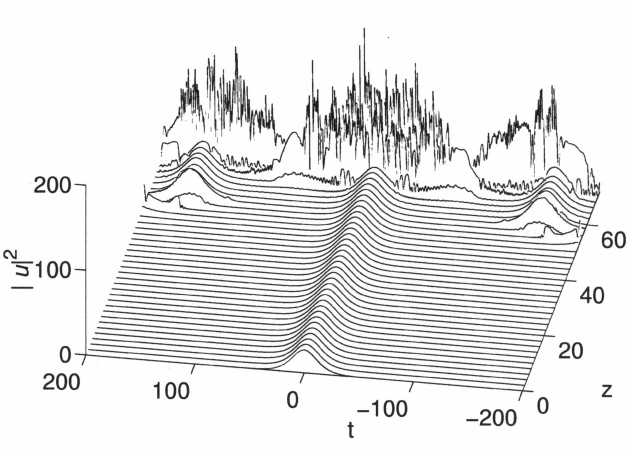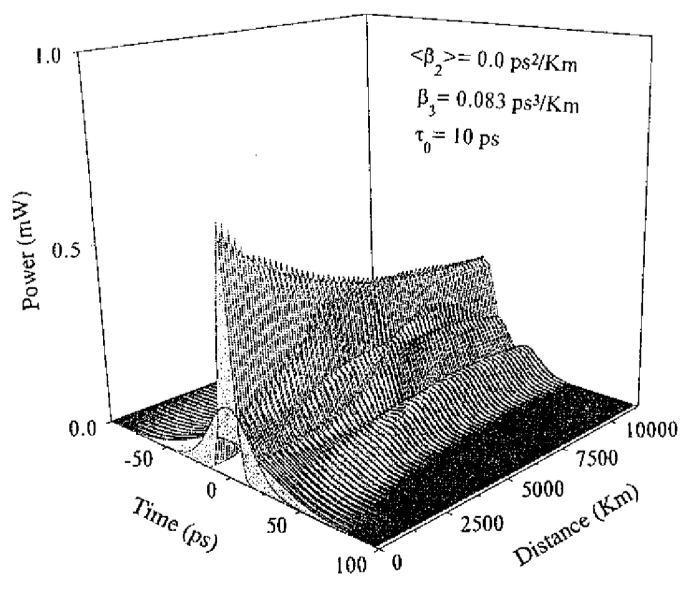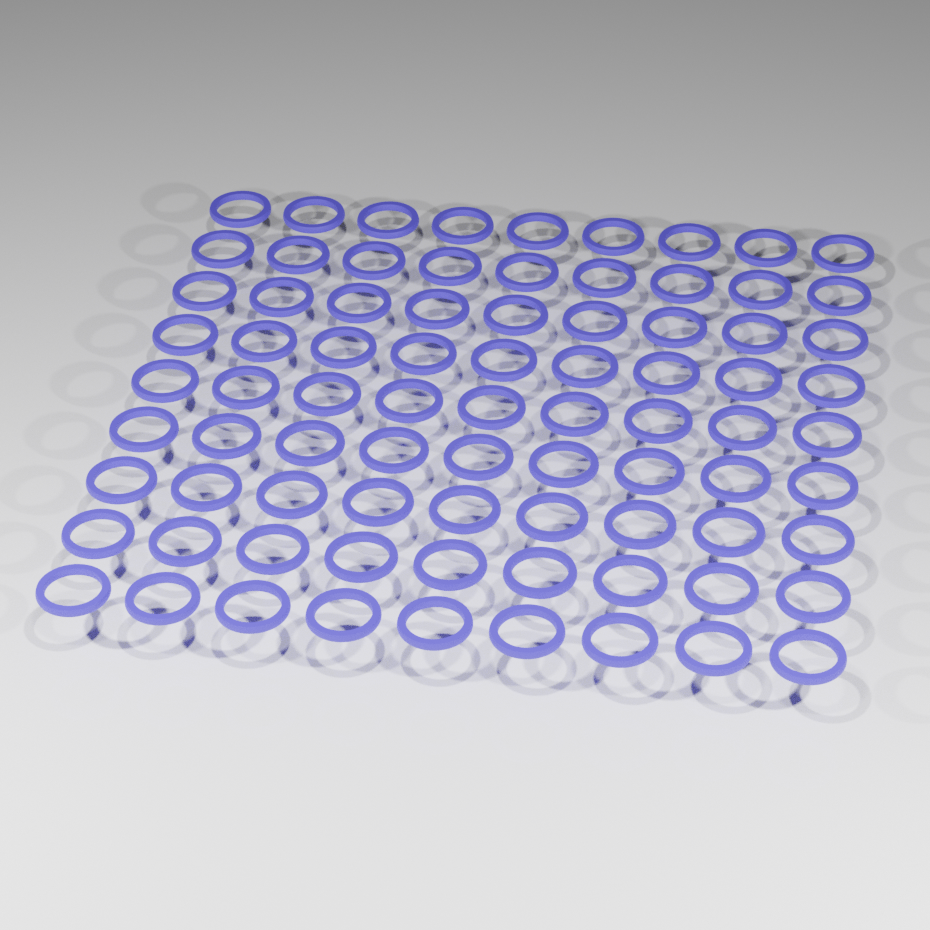
|
Statistical mechanics can provide a versatile theoretical framework for investigating the collective dynamics of weakly nonlinear waves-settings that can be utterly complex to describe otherwise. In optics, composite systems arise due to interactions between different frequencies and/or polarizations. The purpose of this work is to develop a thermodynamic theory that takes into account the synergistic action of multiple components. We find that the type of the nonlinearity involved can have important implications in the thermalization process and, hence, can lead to different thermal equilibrium conditions. Importantly, we derive closed-form expressions for the actual optomechanical pressure that is exerted on the system. In particular, the total optomechanical pressure is the sum of the partial pressures due to each component. Our results can be applied to a variety of weakly nonlinear optical settings such as multimode fibers, bulk waveguides, photonic lattices, and coupled microresonators. We present two specific examples, where two colors interact in a waveguide array with either a cubic or quadratic nonlinearity. |
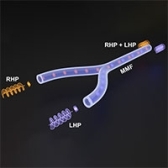
|
The theory of optical thermodynamics provides a comprehensive framework that enables a self-consistent description of the intricate dynamics of nonlinear multimoded photonic systems. This theory, among others, predicts a pressurelike intensive quantity (p̂) that is conjugate to the system's total number of modes (M) - its corresponding extensive variable. Yet at this point, the nature of this intensive quantity is still nebulous. In this Letter, we elucidate the physical origin of the optical thermodynamic pressure and demonstrate its dual essence. In this context, we rigorously derive an expression that splits p̂ into two distinct components, a term that is explicitly tied to the electrodynamic radiation pressure and a second entropic part that is responsible for the entropy change. We utilize this result to establish a formalism that simplifies the quantification of radiation pressure under nonlinear equilibrium conditions, thus eliminating the need for a tedious evaluation of the Maxwell stress tensor. Our theoretical analysis is corroborated by numerical simulations carried out in highly multimoded nonlinear optical structures. These results may provide a novel way in predicting and controlling radiation pressure processes in a variety of nonlinear electromagnetic settings. |
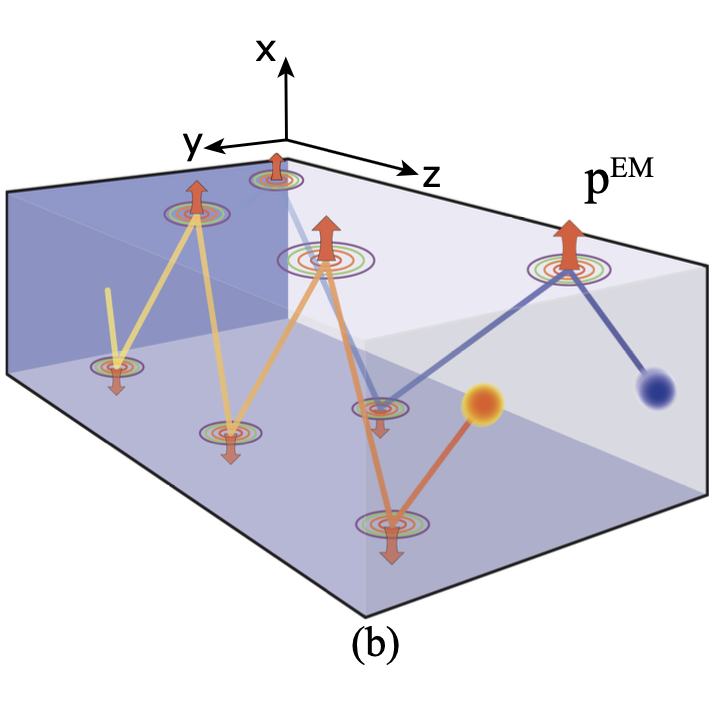
|
The theory of optical thermodynamics provides a comprehensive framework that enables a self-consistent description of the intricate dynamics of nonlinear multimoded photonic systems. This theory, among others, predicts a pressurelike intensive quantity (p̂) that is conjugate to the system's total number of modes (M) - its corresponding extensive variable. Yet at this point, the nature of this intensive quantity is still nebulous. In this Letter, we elucidate the physical origin of the optical thermodynamic pressure and demonstrate its dual essence. In this context, we rigorously derive an expression that splits p̂ into two distinct components, a term that is explicitly tied to the electrodynamic radiation pressure and a second entropic part that is responsible for the entropy change. We utilize this result to establish a formalism that simplifies the quantification of radiation pressure under nonlinear equilibrium conditions, thus eliminating the need for a tedious evaluation of the Maxwell stress tensor. Our theoretical analysis is corroborated by numerical simulations carried out in highly multimoded nonlinear optical structures. These results may provide a novel way in predicting and controlling radiation pressure processes in a variety of nonlinear electromagnetic settings. |
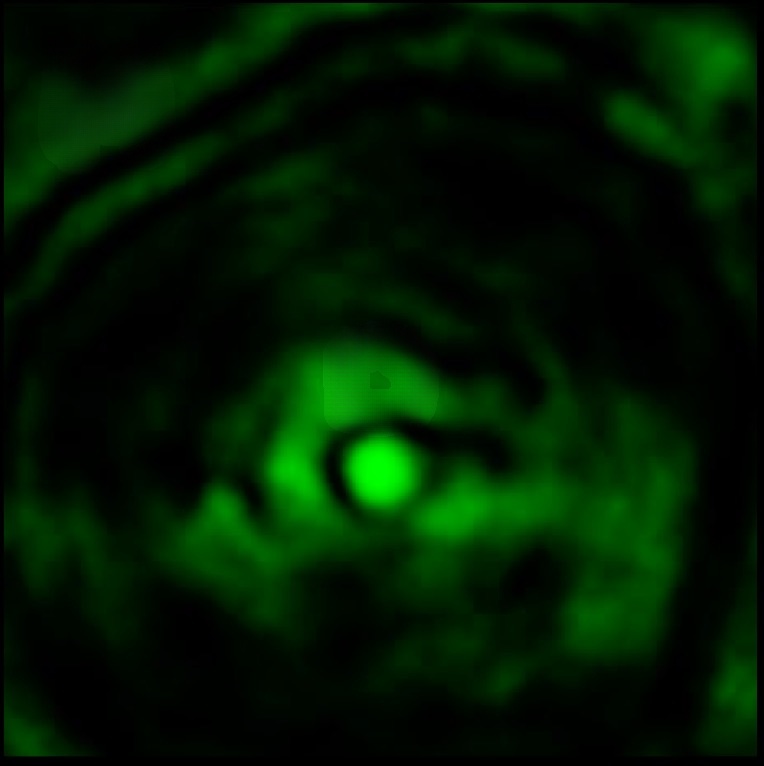
|
We introduce a new class of optical beams, which feature a spatial profile akin to an "inverted pin". In particular, we asymptotically find that close to the axis the transverse amplitude profile of such beams takes the form of a Bessel function with width that gradually increases during propagation. We examine numerically the behavior of such inverted pin beams in turbulent environments as measured via the scintillation index, and show that they outperform Gaussian beams (collimated and focused) as well as Bessel beams and regular pin beams, which are all optimized, especially in the moderate and strong fluctuation regimes. |
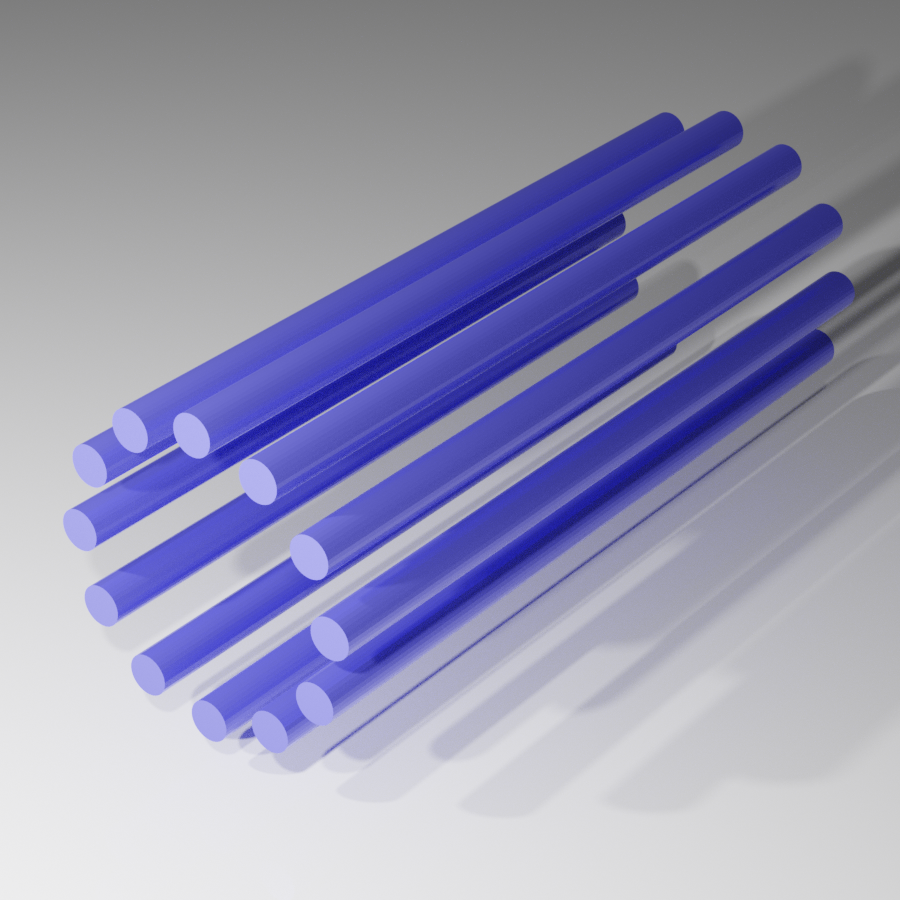
|
Optical forces are known to arise in a universal fashion in many and diverse physical settings. As such, they are successfully employed over a wide range of applications in areas like biophotonics, optomechanics and integrated optics. While inter-elemental optical forces in few-mode photonic networks have been so far systematically analyzed, little is known, if any, as to how they manifest themselves in highly multimoded optical environments. In this work, by means of statistical mechanics, we formally address this open problem in optically thermalized weakly nonlinear heavily multimode tight-binding networks. The outlined thermodynamic formulation allows one to obtain in an elegant manner analytical results for the exerted thermodynamic pressures in utterly complex arrangements-results that are either computationally intensive or impossible to obtain otherwise. Thus, we derive simple closed-form expressions for the thermodynamic optical pressures displayed among elements, which depend only on the internal energy as well as the coupling coefficients involved. In all cases, our theoretical results are in excellent agreement with numerical computations. Our study may pave the way towards a deeper understanding of these complex processes and could open up avenues in harnessing radiation forces in multimode optomechanical systems. |
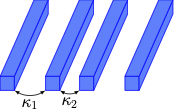
|
We examine the coupling process between the surface modes of a Su-Schrieffer-Heeger lattice both in the linear and the nonlinear regimes. We first develop a coupled-mode theory formalism for the modes of a finite lattice with zero boundary conditions. Our analysis relies on the closed-form expressions for the bulk and the surface eigenmodes of the system. The coupled-mode theory formalism is based on a decomposition of the supermodes into sublattice modes. In the case of the two zero sublattice surface modes, this leads to periodic oscillations between them without the involvement of the bulk modes. We analytically show that launching light only on the waveguide that is located at either edge of the array, can be very effective in successfully exciting the respective surface mode. We extend our analysis, in the case of Kerr nonlinearity, and develop a simplified model that accounts only for the surface modes. By direct numerical simulations, we find that this model can very accurately capture the dynamics of the surface modes when the nonlinearity is small or moderate. On the other hand, in the case of strong nonlinearity, wave mixing leads to the quasiperiodic excitation of the bulk modes, or even to a chaotic behavior where all the modes of the systems are excited, and no prominent signature of the surface modes can be detected. |
(Optics in 2021: Special issue of Optics & Photonics News highlights exciting peer-reviewed optics research that has emerged over the past year).
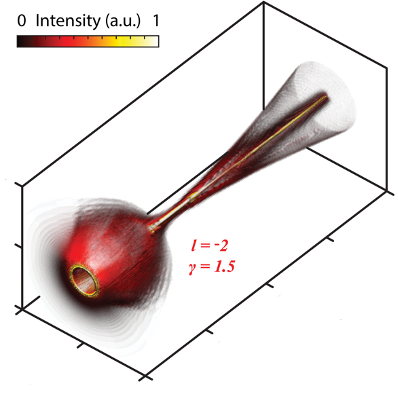
|
We review on our recent theoretical and experimental work on shape-preserving "vortex optical pin beams" that possess stable wavefronts against diffraction and ambient turbulence during free-space long distance propagation. |
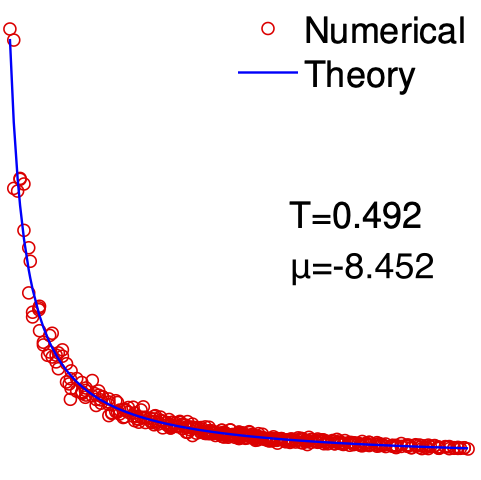
|
We study the statistical behavior of multimoded optical systems under equilibrium conditions. We investigate the role of variations of the system parameters in the thermodynamic description and derive, an optical analogue of the first law of thermodynamics, a generic expression for the work done to the system, and an optical Gibbs-Duhem equation. To demonstrate these effects, we focus in the case of two-dimensional photonic lattices. We study the conditions under which the entropy in such waveguide arrays can be considered as extensive. In this respect, small deviations from the extensive character of the entropy give rise to stress and strain terms. We examine how the conservation laws in such array configurations are affected by variations in the system parameters, and furthermore, we analyze the respective thermodynamic processes (isentropic and Joule-type expansions). |
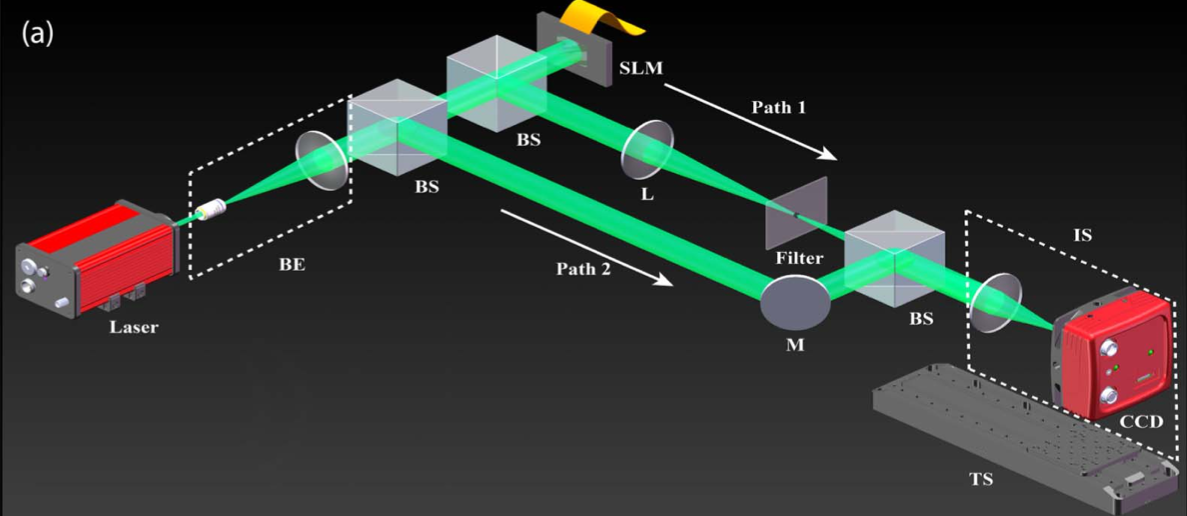
|
We demonstrate, both analytically and experimentally, free-space pin-like optical vortex beams (POVBs). Such angular-momentum-carrying beams feature tunable peak intensity and undergo robust anti-diffracting propagation, realized by judiciously modulating both the amplitude and the phase profile of a standard laser beam. Specifically, they are generated by superimposing a radially-symmetric power-law phase on a helical phase structure, which allows the inclusion of an orbital angular momentum term to the POVBs. During propagation in free-space, these POVBs initially exhibit autofocusing dynamics, and subsequently, their amplitude patterns morph into a high-order Bessel-like profile characterized by a hollow-core and an annular main-lobe with a constant or tunable width during propagation. In contrast with numerous previous endeavors on Bessel beams, our work represents the first demonstration of long-distance free-space generation of optical vortex "pins", with their peak intensity evolution controlled by the impressed amplitude structure. Both the Poynting vectors and the optical radiation forces associated with these beams are also numerically analyzed, revealing novel properties that may be useful for a wide range of applications. |
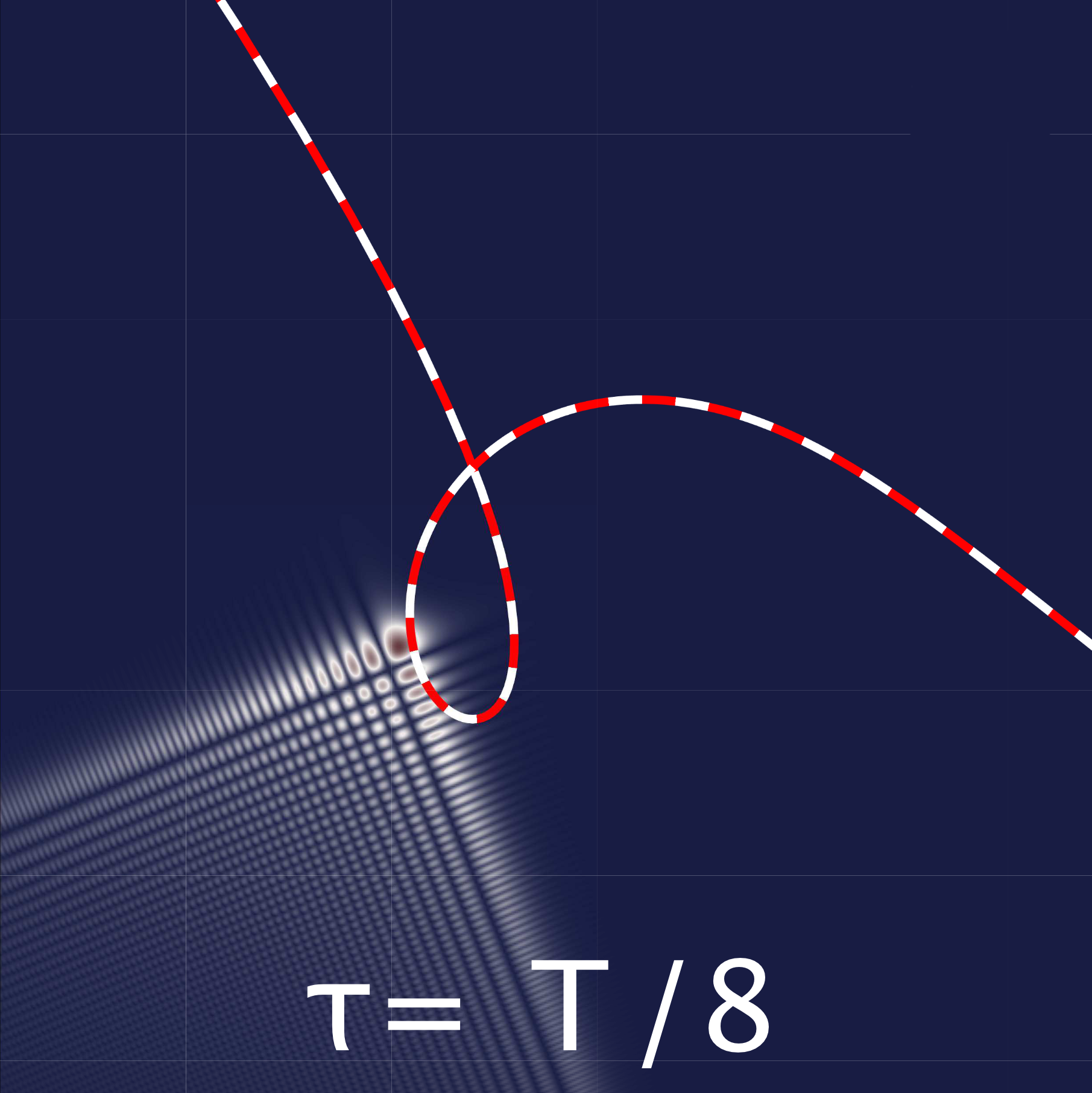
|
We examine the dynamics of electron beams that, in free space, are self-accelerating, in the presence of an additional magnetic field. We focus our attention in the case of Airy beams that follow parabolic trajectories and in generalized classes of beams associated with power-law trajectories. We study the interplay between beam self-acceleration and the circular motion caused by the magnetic field. In the case of Airy beams, using an integral representation, we find closed-form solutions for the electron wavefunction. We also derive asymptotic formulas for the beam trajectories both for Airy beams and for self-accelerating power-law beams. A ray optics description is rather useful for the interpretation of the beam dynamics. Our results are in excellent comparison with direct numerical simulations. |
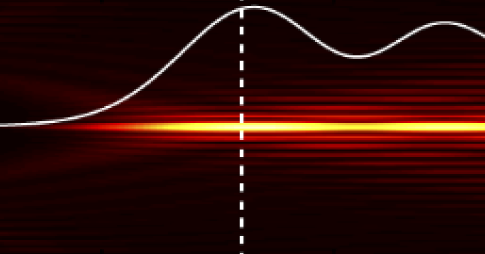
|
We propose and demonstrate a generalized class of anti-diffracting optical pin-like beams (OPBs). Such optical beams exhibit autofocusing dynamics while morphing into a Bessel-like shape during long-distance propagation, where the size of their main lobe can be tuned by an exponent parameter. In particular, their amplitude envelope can be engineered to preserve the pin-like peak intensity pattern. In both theory and experiment, the OPBs are directly compared with radially symmetric abruptly autofocusing beams (AABs) under the same conditions. Furthermore, enhanced transmission and robustness of the OPBs are observed while traversing a scattering colloidal suspension, as compared to both AABs and conventional Bessel beams. |
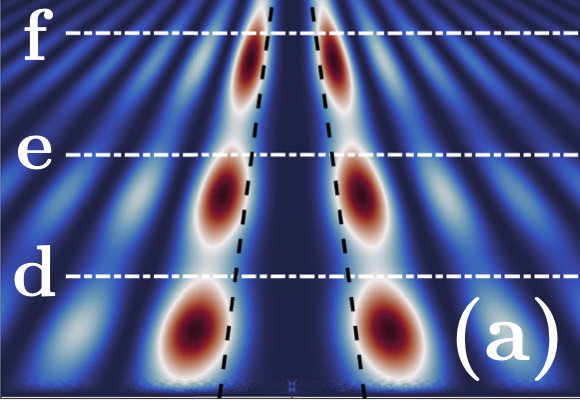
|
We predict that Bessel-like beams of arbitrary integer order can exhibit a tunable self-similar behavior (that take an invariant form under suitable stretching transformations). Specifically, by engineering the amplitude and the phase on the input plane in real space, we show that it is possible to generate higher-order vortex Bessel-like beams with fully controllable radius of the hollow core and maximum intensity during propagation. In addition, using a similar approach, we show that it is also possible to generate zeroth order Bessel-like beams with controllable beam width and maximum intensity. Our numerical results are in excellent agreement with our theoretical predictions. |
(Optics in 2019: Special issue of Optics & Photonics News highlights exciting peer-reviewed optics research that has emerged over the past year).
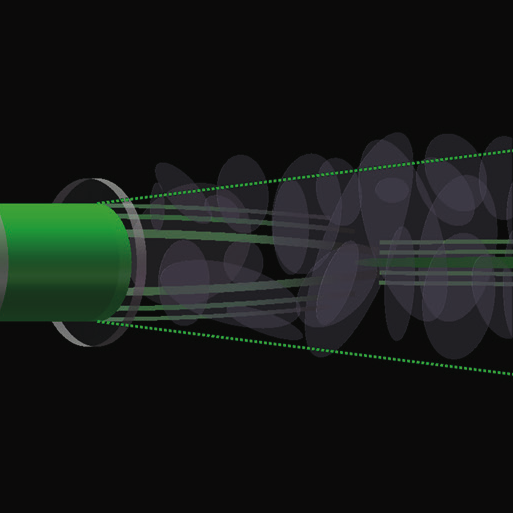
|
We review on our recent theoretical and experimental work on shape-preserving "optical pin beams" (OPBs) that possess stable wavefronts against diffraction and ambient turbulence during free-space long distance propagation. |
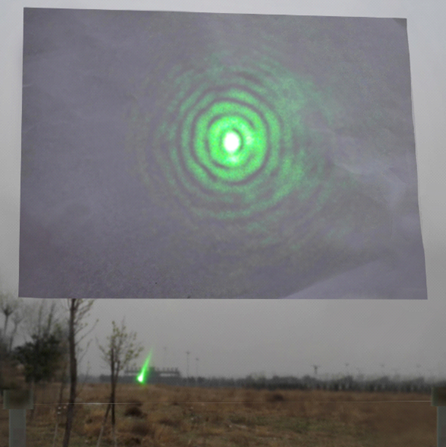
|
We design and demonstrate what we called shape-preserving "optical pin beams" (OPBs) that possess stable wavefronts against diffraction and ambient turbulence during free-space long distance propagation. Theoretically, we show that a laser beam passing through properly assembled phase elements paired with opposite transverse wavevectors can morph quickly into a stable optical field, exhibiting "self-focusing" dynamics during propagation without optical nonlinearity. The overall shape of such OPBs remains invariant, while their width can in principle be inversely proportional to the propagation distance, in contradistinction to conventional Bessel beams and radially symmetric Airy beams. Experimentally, utilizing a single photoetched mask, we demonstrate efficient generation and robust propagation of the OPB through atmospheric turbulence beyond kilometer distances. We envisage exciting opportunities arising from such OPBs, especially when propagation through turbulent environments is unavoidable. |
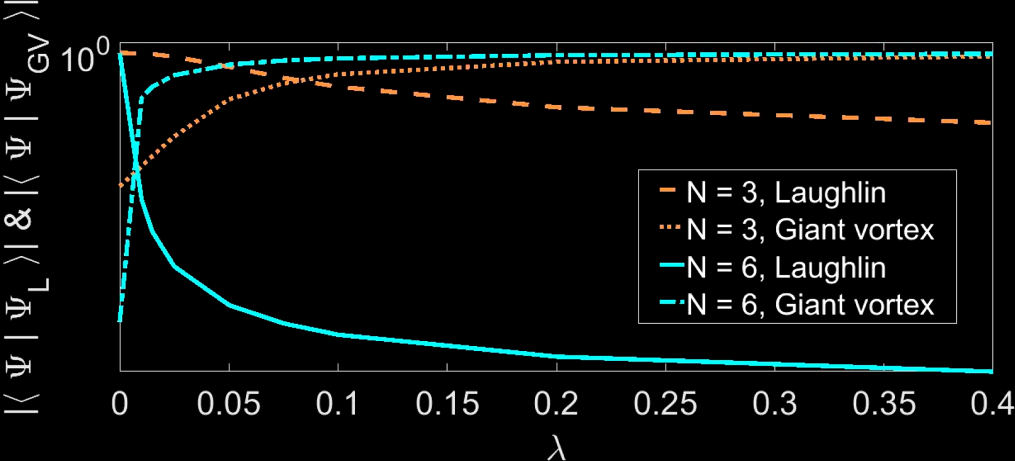
|
We demonstrate the fragility of the bosonic Laughlin state, considering as an example a rotating Bose-Einstein condensate. In the presence of a harmonic potential, an additional weak, quartic, potential makes the Laughlin state highly fragile. Our results imply that achieving this state experimentally is essentially impossible, at least for a macroscopic atom number. We also argue that the fragility of the Laughlin state is generic and not specific to the system considered here. |
Ranked No 5 in the Optica top downloads for May 2019
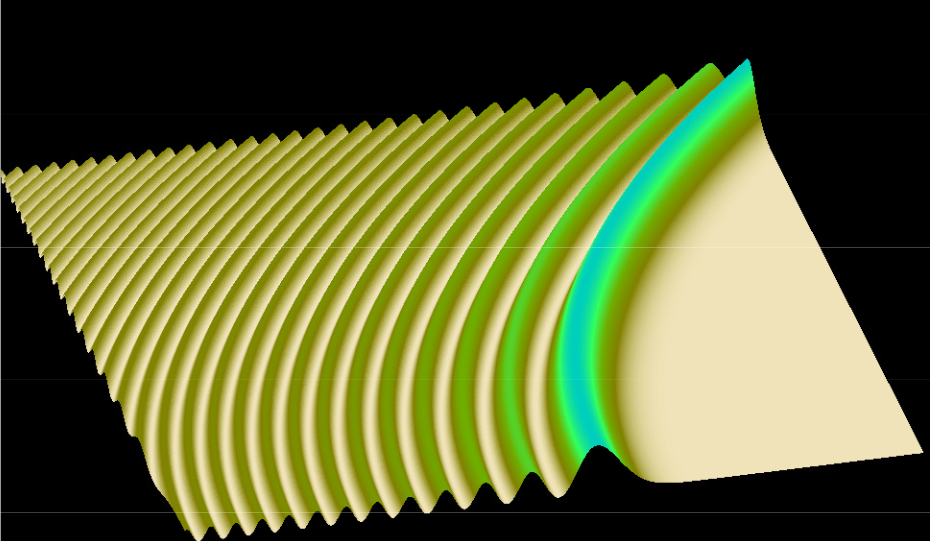
|
Over the last dozen years, the area of accelerating waves has made considerable advances not only in terms of fundamentals and experimental demonstrations, but also in connection to a wide range of applications. Starting from the prototypical Airy beam that was proposed and observed in 2007, new families of accelerating waves have been identified in the paraxial and nonparaxial domains in space and/or time, with different methods developed to control at will their trajectory, amplitude, and beam width. Accelerating optical waves exhibit a number of highly desirable attributes. They move along a curved or accelerating trajectory while being resilient to perturbations (self-healing) and are diffraction-free. It is because of these particular features that accelerating waves have been utilized in a variety of applications in the areas of filamentation, beam focusing, particle manipulation, biomedical imaging, plasmons, and material processing, among others. |
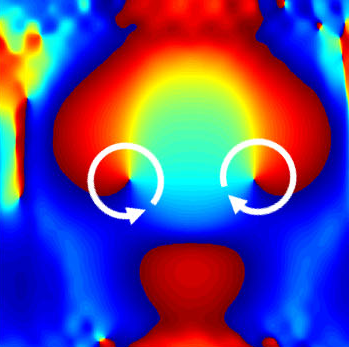
|
We demonstrate valley-dependent vortex generation in photonic graphene. Without breaking inversion symmetry, the excitation of two valleys leads to the formation of an optical vortex upon Bragg reflection to the third equivalent valley, with its chirality determined by the valley degree of freedom. Vortex-antivortex pairs with valley-dependent topological charge flipping are also observed and corroborated by numerical simulations. Furthermore, we develop a three-band effective Hamiltonian model to describe the dynamics of the coupled valleys and find that the commonly used two-band model is not sufficient to explain the observed vortex degeneracy lifting. Such valley-polarized vortex states arise from high-band excitation without a synthetic-field-induced gap opening. Our results from a photonic setting may provide insight for the study of valley contrasting and Berry-phase-mediated topological phenomena in other systems. |
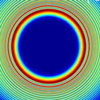
|
We predict and experimentally observe three-dimensional microscale nonparaxial optical bottle beams based on the generation of a caustic surface under revolution. Such bottle beams exhibit high contrast between the surrounding surface and the effectively void interior. Via caustic engi- neering, we can precisely control the functional form of the high-intensity surface to achieve microscale bottle beams with longitudinal and transverse dimensions of the same order of magnitude. Although, in general, the phase profile at the input plane can be computed numeri- cally, we find closed-form expressions for bottle beams with various types of surfaces both in the real and in the Fourier space. |
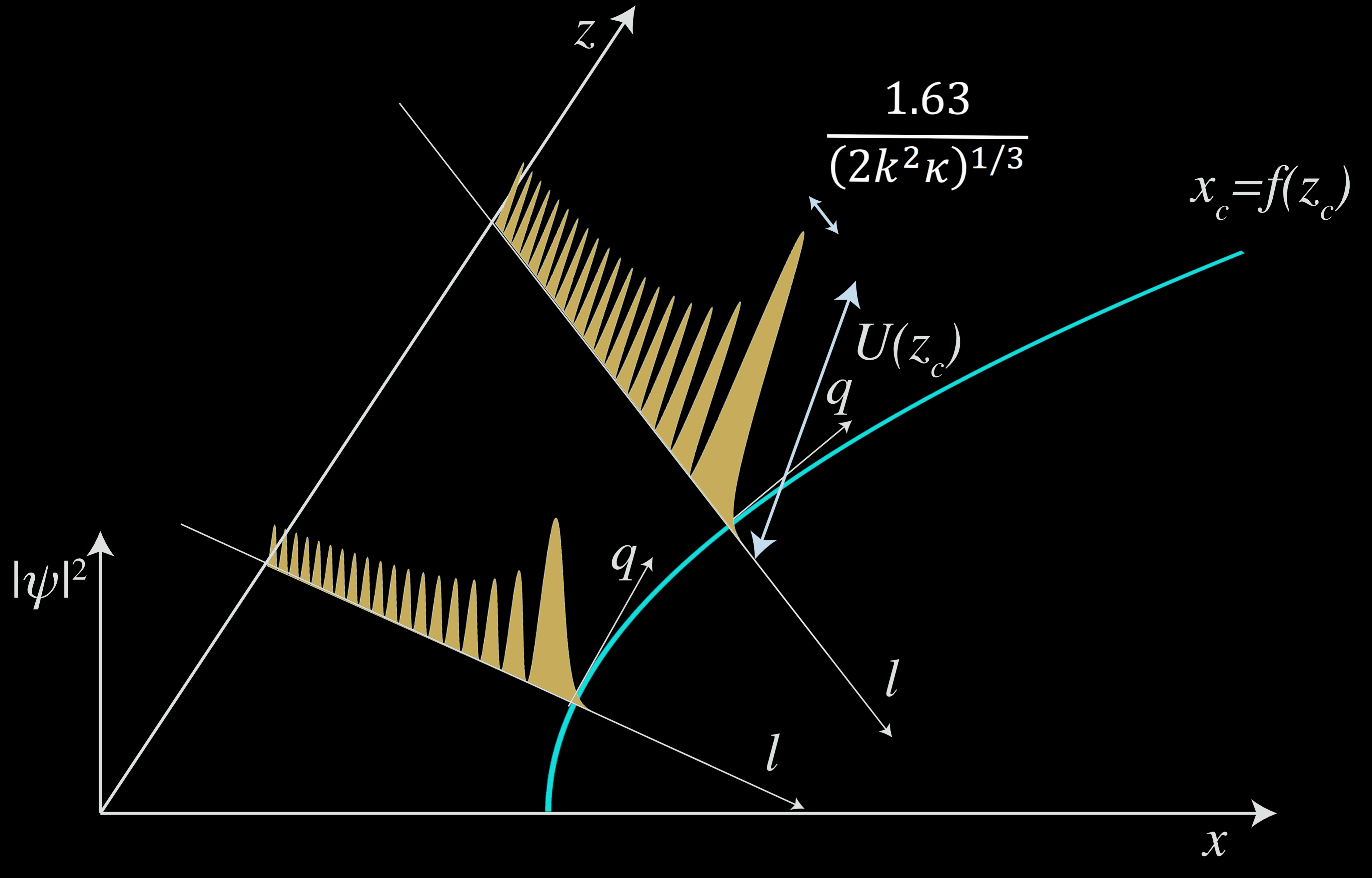
|
We show that it is possible to generate non-paraxial optical beams with pre-engineered trajectories and designed maximum amplitude along these trajectories. The independent control of these two degrees of freedom is made possible by engineering both the amplitude and the phase of the optical wave on the input plane. Furthermore, we come to the elegant conclusion that the beam width depends solely on the local curvature of the trajectory. Thus, we can generate beams with pre-defined amplitude and beam-width by appropriately selecting the local curvature. Our theoretical results are in excellent agreement with numerical simulations. We discuss about methods that can be utilized to experimentally generate such beam. Our work might be useful in applications where precise beam control is important such as particle manipulation, filamentation, and micromachining. |
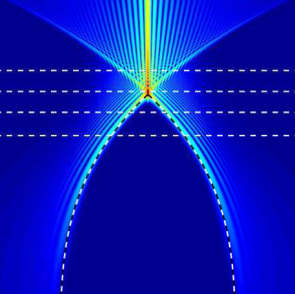
|
We show that it is possible to independently control both the trajectory and the maximum amplitude along the trajectory of a paraxial accelerating beam. This is accomplished by carefully engineering both the amplitude and the phase of the beam on the input plane. Furthermore, we show that the width of an accelerating beam is related only on the curvature of the trajectory. Therefore, we are able to produce beams with predefined beam widths and amplitudes. These results are useful in applications where precise beam control is important. In addition we consider radially symmetric abruptly autofocusing beams. We identify the important parameters that affect the focal characteristics. Consequently, we can design autofocusing beams with optimized parameters (such as sharper focus and higher intensity contrast). In all our calculations the resulting formulas are presented in an elegant and practical form in direct connection with the geometric properties of the trajectory. Finally we discuss methods that can be utilized to experimentally realize such optical waves. |
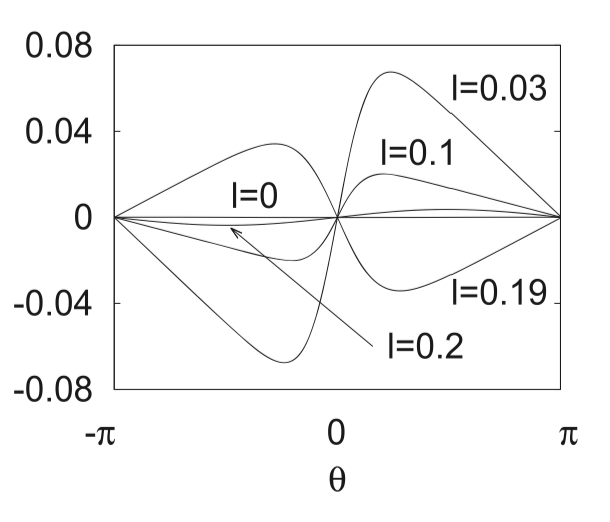
|
We study the rotational properties of a two-component Bose-Einstein condensed gas of distinguishable atoms which are confined in a ring potential using both the mean-field approximation, as well as the method of diagonalization of the many-body Hamiltonian. We demonstrate that the angular momentum may be given to the system either via single-particle, or 'collective' excitation. Furthermore, despite the complexity of this problem, under rather typical conditions the dispersion relation takes a remarkably simple and regular form. Finally, we argue that under certain conditions the dispersion relation is determined via collective excitation. The corresponding many-body state, which, in addition to the interaction energy minimizes also the kinetic energy, is dictated by elementary number theory. |
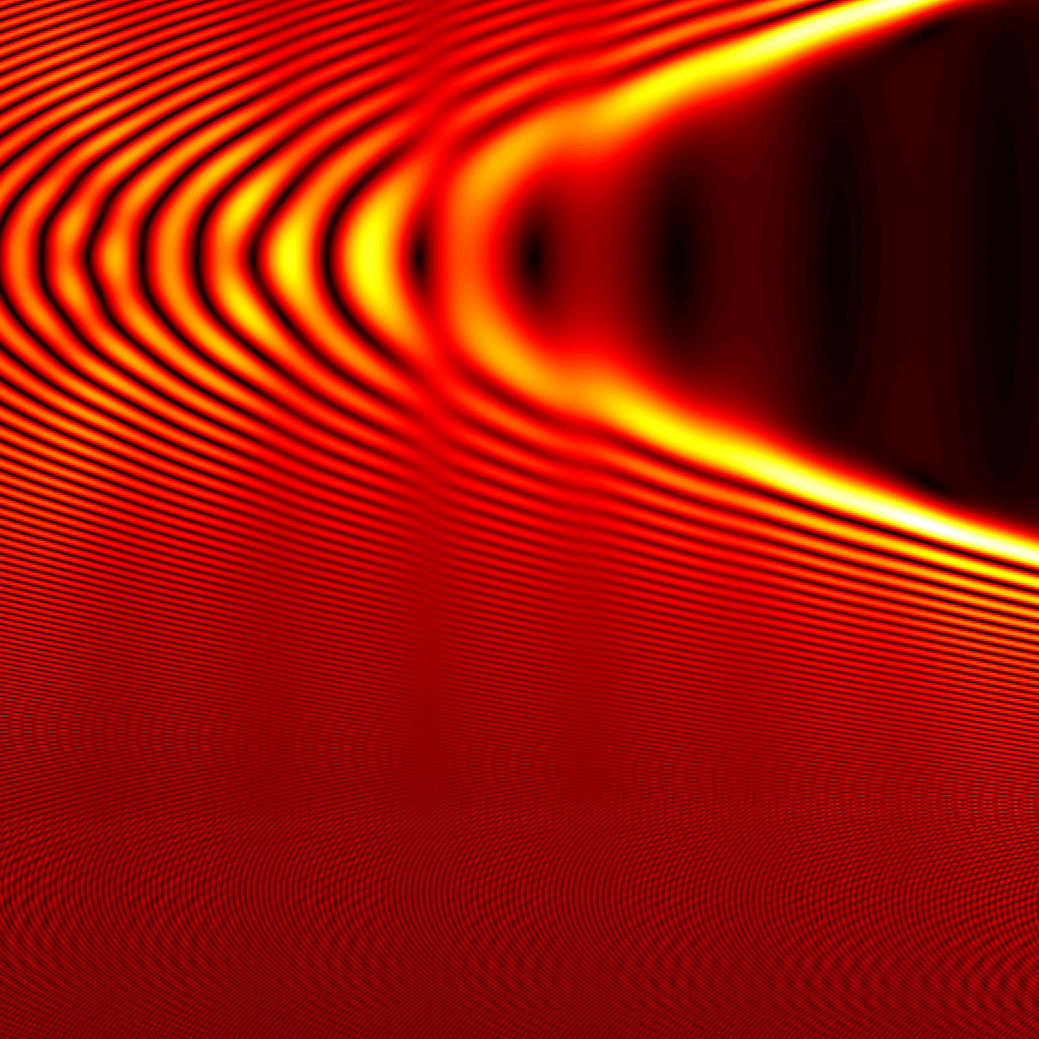
|
We investigate the dynamics of spatiotemporal optical waves with one transverse dimension obtained as the intersections of the dispersion cone with a plane. We show that, by appropriate spectral excitations, the three different types of conic sections (elliptic, parabolic, and hyperbolic) can lead to optical waves of the Bessel, Airy, and modified Bessel types, respectively. We find closed form solutions that accurately describe the wave dynamics and unveil their fundamental properties. |
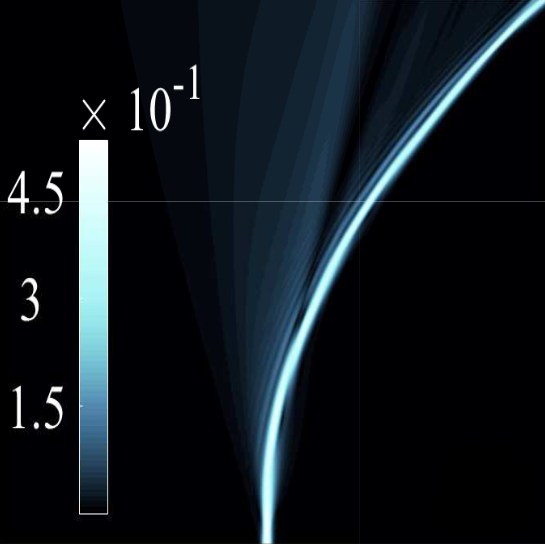
|
We show that the velocity and thus the frequency of a signal pulse can be adjusted by the use of a control Airy pulse. In particular, we utilize a nonlinear Airy pulse which, via cross-phase modulation, creates an effective potential for the optical signal. Interestingly, during the interaction, the signal dispersion is suppressed. Importantly, the whole process is controllable and by using Airy pulses with different truncations leads to predetermined values of the frequency shifting. Such a functionality might be useful in wavelength division multiplexing |
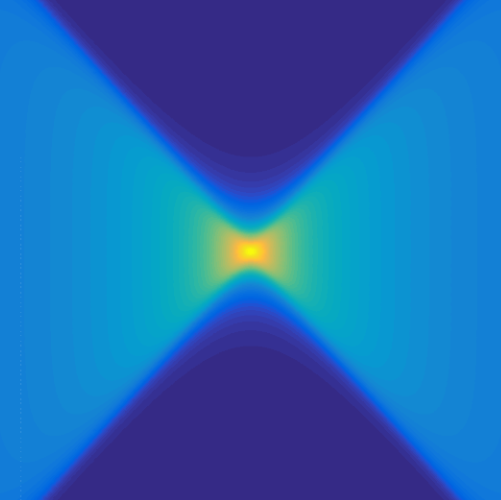
|
We find exact solutions describing bidirectional pulses propagating in fiber Bragg gratings. They are derived by solving the coupled-mode theory equations and are expressed in terms of products of modified Bessel functions with algebraic functions. Depending on the values of the two free parameters, the general bidirectional X-wave solution can also take the form of a unidirectional pulse. We analyze the symmetries and the asymptotic properties of the solutions and also discuss additional waveforms that are obtained by interference of more than one solution. Depending on their parameters, such pulses can create a sharp focus with high contrast. |
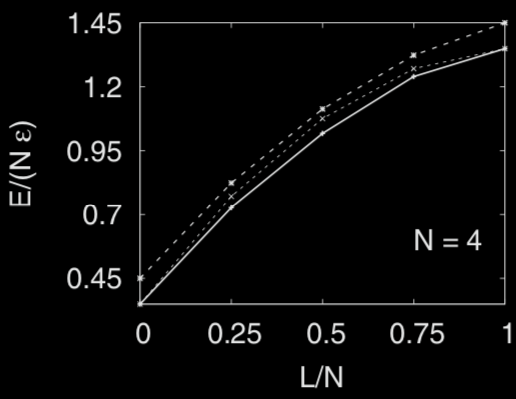
|
We study the rotational properties of a two-component Bose-Einstein condensed gas of distinguishable atoms which are confined in a ring potential using both the mean-field approximation, as well as the method of diagonalization of the many-body Hamiltonian. We demonstrate that the angular momentum may be given to the system either via single-particle, or 'collective' excitation. Furthermore, despite the complexity of this problem, under rather typical conditions the dispersion relation takes a remarkably simple and regular form. Finally, we argue that under certain conditions the dispersion relation is determined via collective excitation. The corresponding many-body state, which, in addition to the interaction energy minimizes also the kinetic energy, is dictated by elementary number theory. |
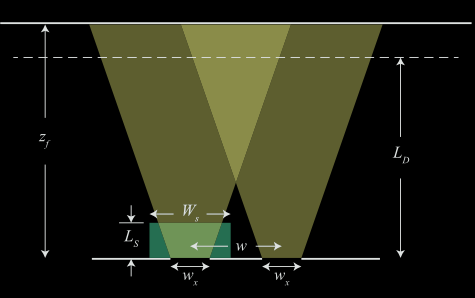
|
We consider an optical nonlinear interferometric setup based on Young’s double-slit configuration where a non- linear material is placed exactly after one of the two slits. We examine the effects of Kerr nonlinearity and multi- photon absorption in the resulting interference pattern. The presence of nonlinearity breaks the transverse spatial symmetry of the system, resulting in a modified intensity pattern at the observation plane as a function of the incident intensity. Our theoretical model, based on the modification of the optical path due to the presence of nonlinearity, is surprisingly accurate in predicting the intensity profile of the main lobes for a wide range of parameters. We discuss potential applications of our model in nonlinear interferometry. Specifically, we show that it is possible to measure both the multiphoton and Kerr coefficients of a nonlinear material based on the spatial translation of the interference pattern as a function of the incident intensity. |
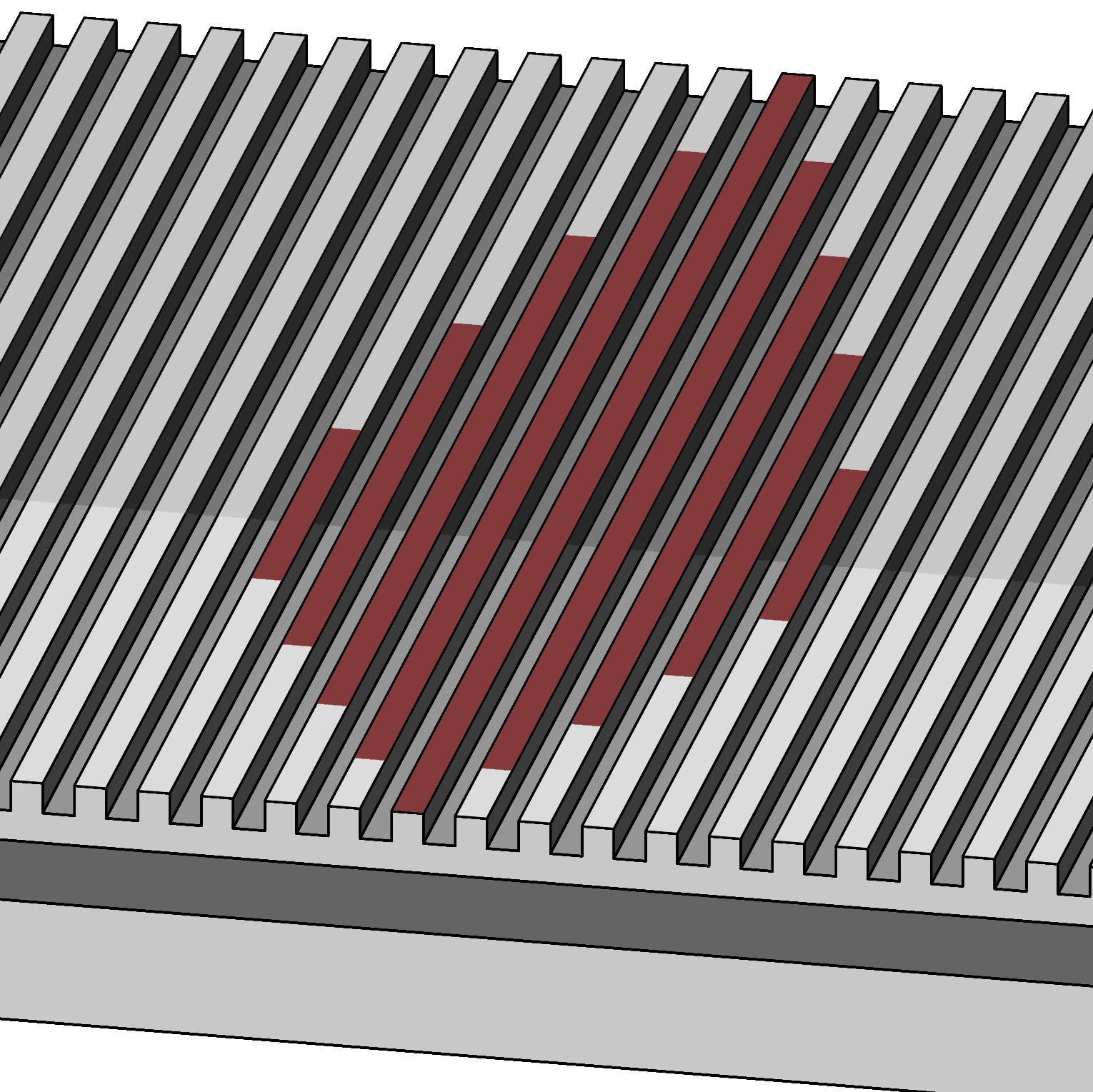
|
We show that nonlinear imaging is possible in periodic waveguide configurations, provided that we use two differ- ent segments of nonlinear media with opposite signs of the Kerr nonlinearity with, in general, no other restriction about their magnitudes. The second medium is used to implement effective "reverse propagation." A main ingredient in achieving nonlinear imaging is the control of the sign and the amplitude of the coupling coefficient. We numerically test our results in one- and two-dimensional square arrangements of waveguides. |
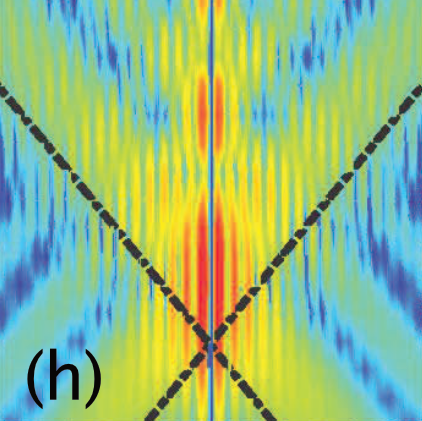
|
We study nonparaxial autofocusing beams with pre-engineered trajectories. We consider the case of linearly polarized electric optical beams and examine their focusing properties, such as contrast, beam width, and numerical aperture. Such beams are associated with larger intensity contrasts, can focus at smaller distances, and have smaller spot sizes as compared to the paraxial regime. |
(Optics in 2015: Special issue of Optics & Photonics News that highlights the most exciting peer-reviewed optics research to have emerged over the past 12 months).
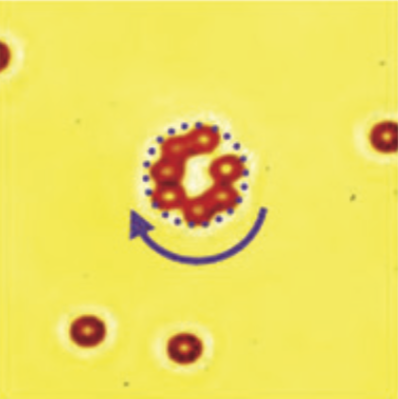
|
We have theoretically shown that, similar to a Bessel-like beam, a judiciously shaped singular beam can be navigated along an arbitrary yet predefined trajectory while preserving OAM and its associated dark "hole" within the main lobe of the beam. We observed a beam that curves along parabolic, hyperbolic and 3-D spiraling trajectories though its field profile asymptotically takes the form of a higher-order Bessel function. We also experimentally demonstrated 3-D manipulation of microparticles by such fine-shaped dynamical beams, including those that can undergo self-breathing and self-propelling in addition to self-bending. |
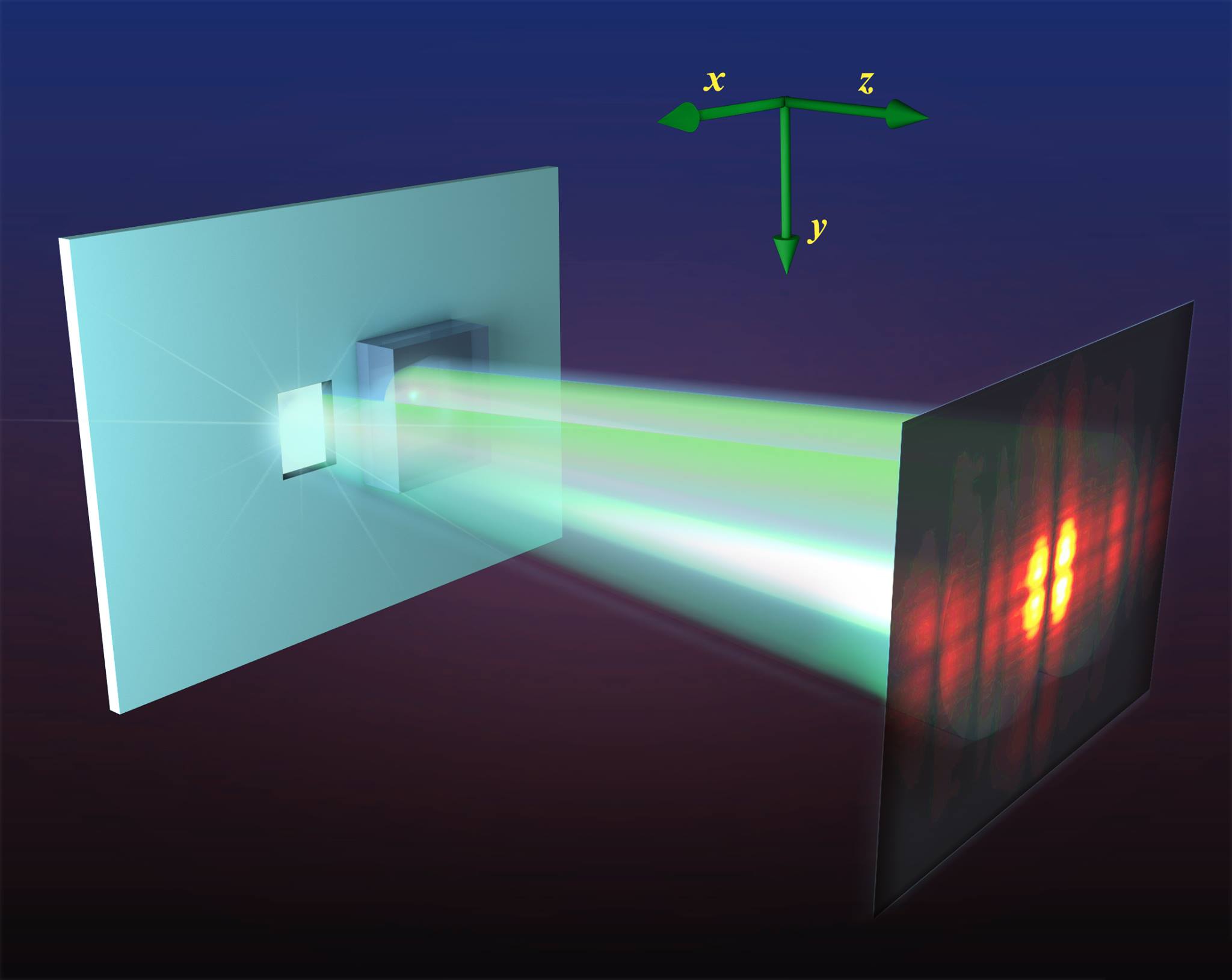
|
In this Letter, we study a nonlinear interferometric setup based on diffraction, rather than beam combining. It consists of a nonlinear analog of Young’s double-slit experiment where a nonlinear material is placed exactly after one of the slits. The presence of nonlinearity breaks the transverse spatial symmetry of the system and, thus, modifies the optical path. For moderate nonlinearities, this leads to a self-induced shift of the intensity pattern in the transverse plane. A simple theoretical model is developed which is surprisingly accurate in predicting the intensity profile of the main lobes for a wide range of parameters. We discuss possible applications of our model in nonlinear interferometry, for example in measuring the nonlinearities of optical materials. |
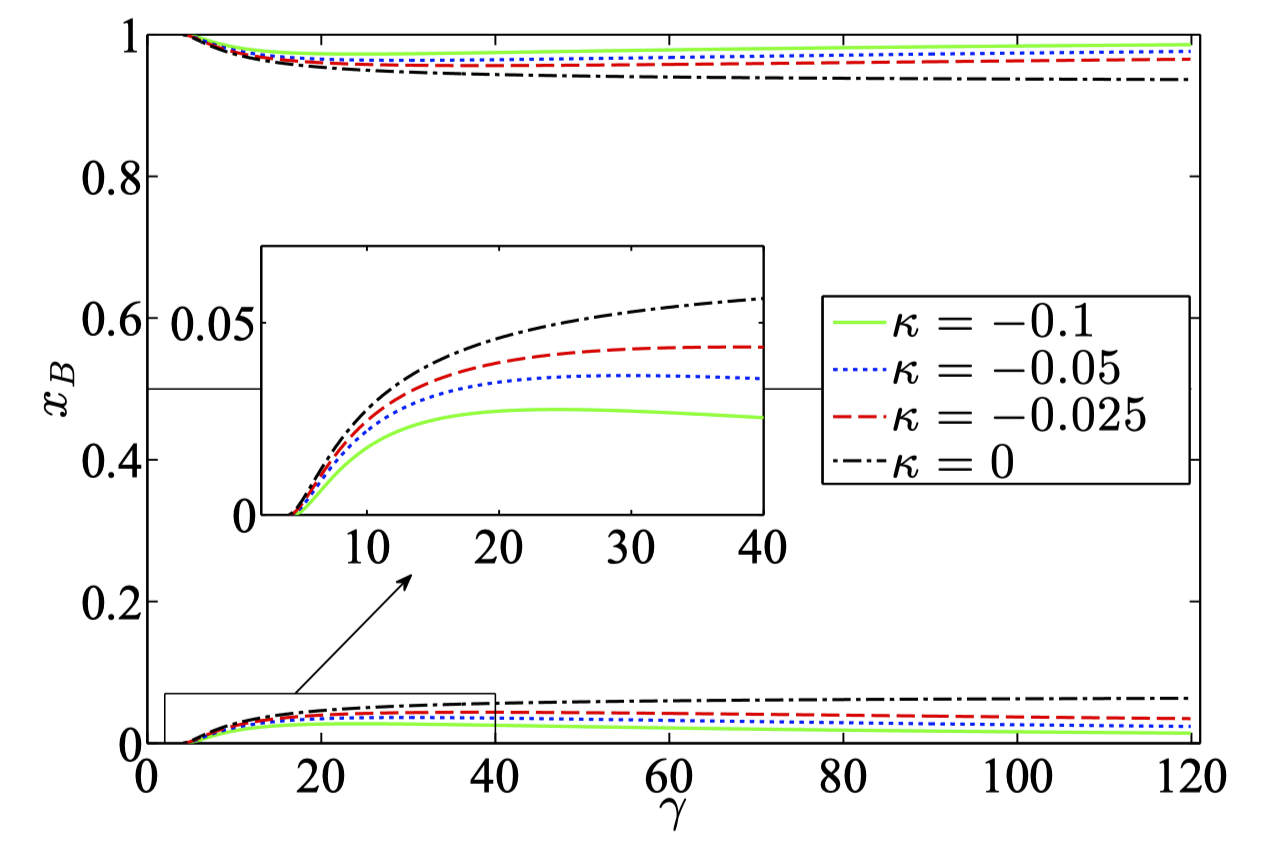
|
We analyze the mean-field yrast spectrum of a two-component Bose gas in the ring geometry with arbitrary interaction asymmetry. Of particular interest is the possibility that the yrast spectrum develops local minima at which persistent superfluid flow can occur. By analyzing the mean-field energy functional, we show that local minima can be found at plane-wave states and arise when the system parameters satisfy certain inequalities. We then go on to show that these plane-wave states can be yrast states even when the yrast spectrum no longer exhibits a local minimum. Finally, we obtain conditions which establish when the plane-wave states cease to be yrast states. Specific examples illustrating the roles played by the various interaction asymmetries are presented. |
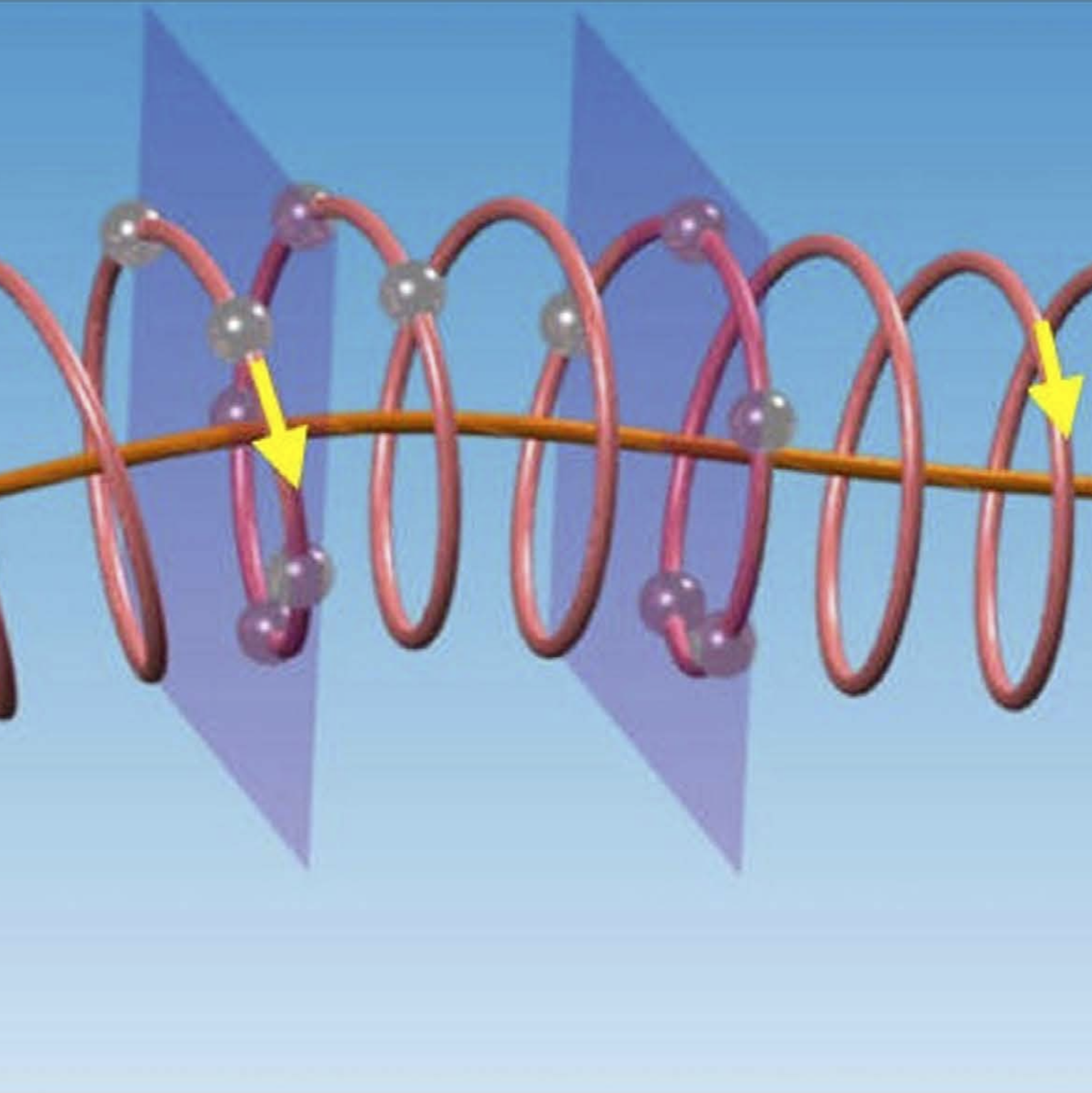
|
For decades, singular beams carrying angular momentum have been a topic of considerable interest. Their intriguing applications are ubiquitous in a variety of fields, ranging from optical manipulation to photon entanglement, and from microscopy and coronagraphy to free-space communications, detection of rotating black holes, and even relativistic electrons and strong-field physics. In most applications, however, singular beams travel naturally along a straight line, expanding during linear propagation or breaking up in nonlinear media. Here, we design and demonstrate diffraction-resisting singular beams that travel along arbitrary trajectories in space. These curved beams not only maintain an invariant dark "hole" in the center but also preserve their angular momentum, exhibiting combined features of optical vortex, Bessel, and Airy beams. Furthermore, we observe three-dimensional spiraling of microparticles driven by such fine-shaped dynamical beams. Our findings may open up new avenues for shaped light in various applications. |
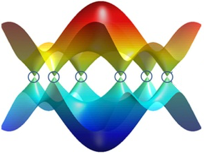
|
We demonstrate controllable generation and destruction of pseudospin-mediated topological charges (vortices) in the photonic analogy of graphene-optically induced honeycomb lattices (HCLs). When only one of the two sublattices is selectively excited by the probe beams that are momentum-matched onto the Dirac points, a singly-charged optical vortex emerges in the output of the symmetric conical diffraction pattern. Furthermore, flipping of the topological charge is observed as the excitation shifts from sublattice A to sublattice B. On the other hand, when both sublattices are simultaneously excited, the conical diffraction pattern becomes highly asymmetric, accompanied by interesting phenomena related to the generation of half-integer vortices and line singularities. We present four different cases of selective excitation using two different approaches; one with three input probe beams that are momentum-matched to the three K valleys, and the other with only two probe beams while the Bloch modes surrounding the third valley are excited due to Bragg reflection. Our experimental results are confirmed by numerical simulation of the paraxial wave equation with a HCL potential as well as by theoretical analysis of the two-dimensional Dirac-Weyl equations directly. These studies indicate that the lattice pseudospin is not just a mathematical formality, but rather it can manifest through its angular momentum transferred to probing optical beams. |
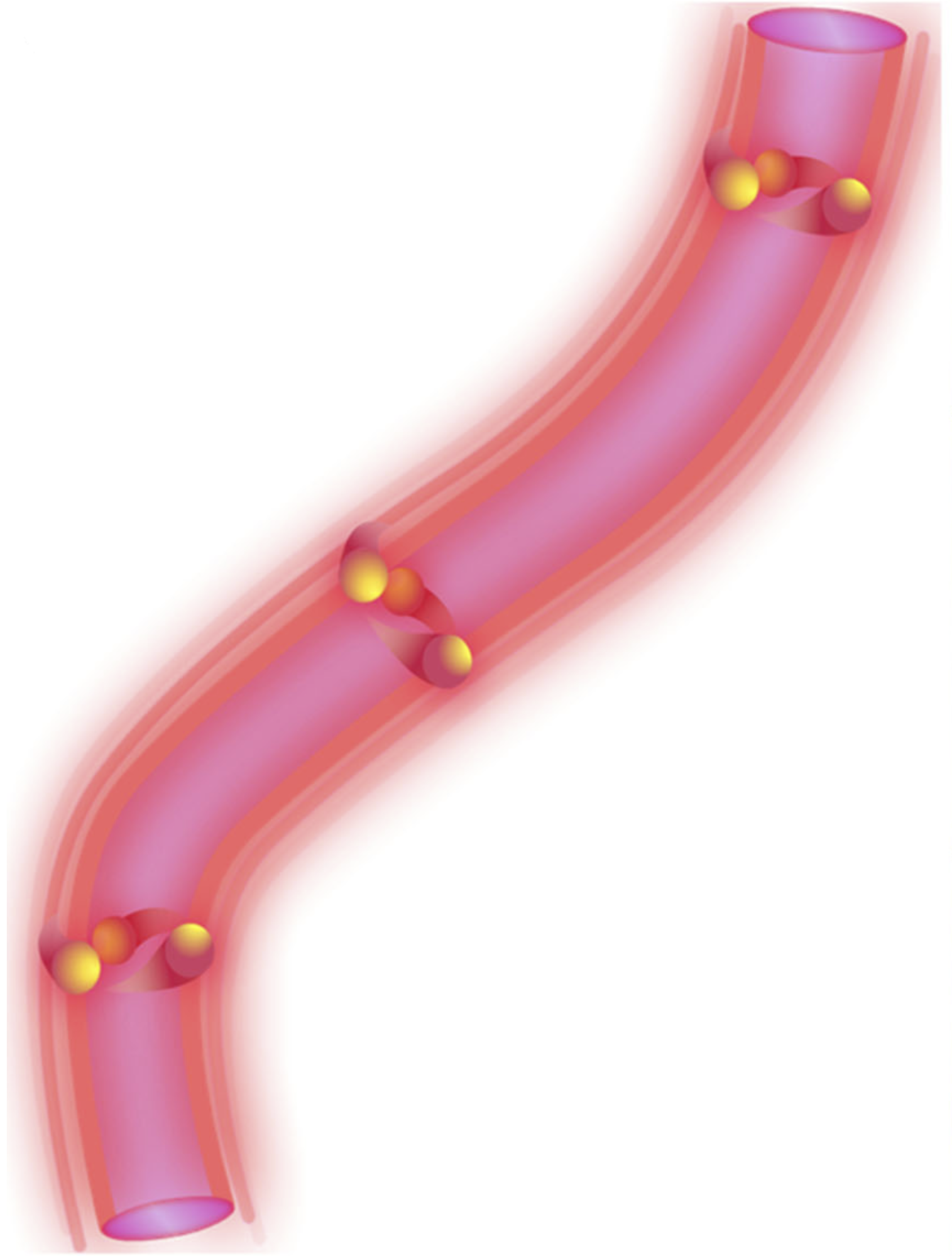
|
Over the past several years, spatially shaped self-accelerating beams along different trajectories have been studied extensively. Due to their useful properties such as resistance to diffraction, self-healing, and self-bending even in free space, these beams have attracted great attention with many proposed applications. Interest- ingly, some of these beams could be designed with con- trollable spatial profiles and thus propagate along various desired trajectories such as parabolic, snake-like, hyper- bolic, hyperbolic secant, three-dimensional spiraling, and even self-propelling trajectories. Experimentally, such beams are realized typically by using a spatial light modulator so as to imprint a desired phase distribution on a Gaussian-like input wave front propagating under paraxial or nonparaxial conditions. In this paper, we provide a brief overview of our recent work on specially shaped self-ac- celerating beams, including Bessel-like, breathing Bessel- like, and vortex Bessel-like beams. In addition, we propose and demonstrate a new type of dynamical Bessel-like beams that can exhibit not only self-accelerating but also self-propelling during propagation. Both theoretical and experimental results are presented along with a brief dis- cussion of potential applications. |
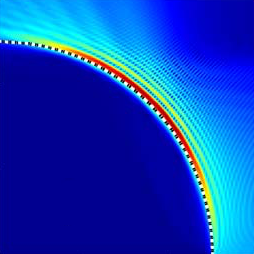
|
In this Letter, we propose a general real-space method for the generation of nonparaxial accelerating beams with arbitrary predefined convex trajectories. Our results lead to closed-form expressions for the required phase at the input plane. We present such closed-form results for a variety of caustic curves: beside circular, elliptic, and para- bolic, we find for the first time general power-law and exponential trajectories. Furthermore, by changing the initial amplitude, we can design different intensity profiles along the caustic. |
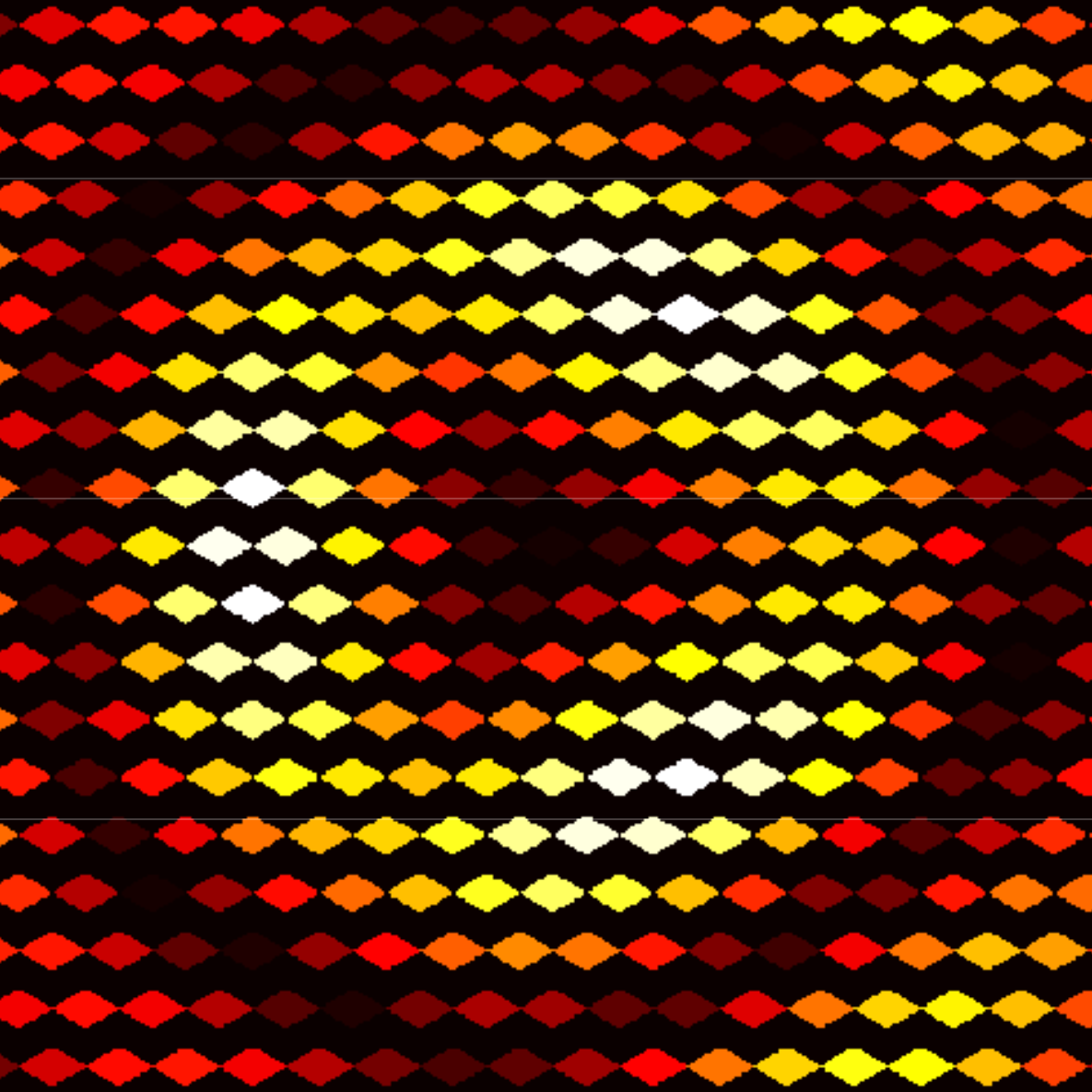
|
We find diffraction-free beams for graphene and MoS2-type honeycomb optical lattices. The resulting composite solutions have the form of multi-vortices, with spinor topological charges (n, |
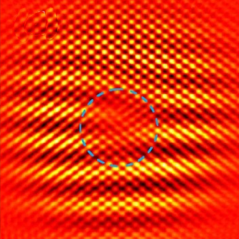
|
Pseudospin, an additional degree of freedom inherent in graphene, plays a key role in understanding many fundamental phenomena such as the anomalous quantum Hall effect, electron chirality and Klein paradox. Unlike the electron spin, the pseudospin was traditionally considered as an unmeasurable quantity, immune to Stern-Gerlach-type experiments. Recently, however, it has been suggested that graphene pseudospin is a real angular momentum that might manifest itself as an observable quantity, but so far direct tests of such a momentum remained unfruitful. Here, by selective excitation of two sublattices of an artificial photonic graphene, we demonstrate pseudospin-mediated vortex generation and topological charge flipping in otherwise uniform optical beams with Bloch momentum traversing through the Dirac points. Corroborated by numerical solutions of the linear massless Dirac-Weyl equation, we show that pseudospin can turn into orbital angular momentum completely, thus upholding the belief that pseudospin is not merely for theoretical elegance but rather physically measurable. |
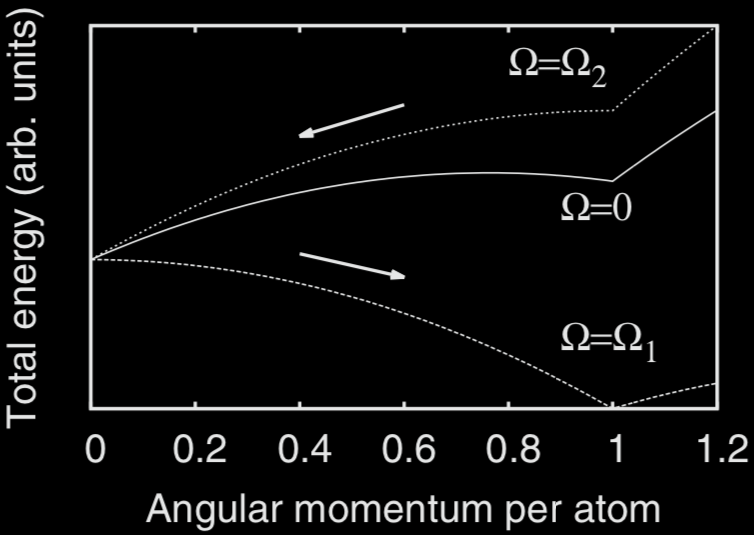
|
We study the rotational properties of a two-component Bose-Einstein condensed gas of distinguishable atoms which are confined in a ring potential using both the mean-field approximation, as well as the method of diagonalization of the many-body Hamiltonian. We demonstrate that the angular momentum may be given to the system either via single-particle, or 'collective' excitation. Furthermore, despite the complexity of this problem, under rather typical conditions the dispersion relation takes a remarkably simple and regular form. Finally, we argue that under certain conditions the dispersion relation is determined via collective excitation. The corresponding many-body state, which, in addition to the interaction energy minimizes also the kinetic energy, is dictated by elementary number theory. |

|
We study the rotational properties of a two-component Bose-Einstein condensed gas of distinguishable atoms which are confined in a ring potential using both the mean-field approximation, as well as the method of diagonalization of the many-body Hamiltonian. We demonstrate that the angular momentum may be given to the system either via single-particle, or 'collective' excitation. Furthermore, despite the complexity of this problem, under rather typical conditions the dispersion relation takes a remarkably simple and regular form. Finally, we argue that under certain conditions the dispersion relation is determined via collective excitation. The corresponding many-body state, which, in addition to the interaction energy minimizes also the kinetic energy, is dictated by elementary number theory. |
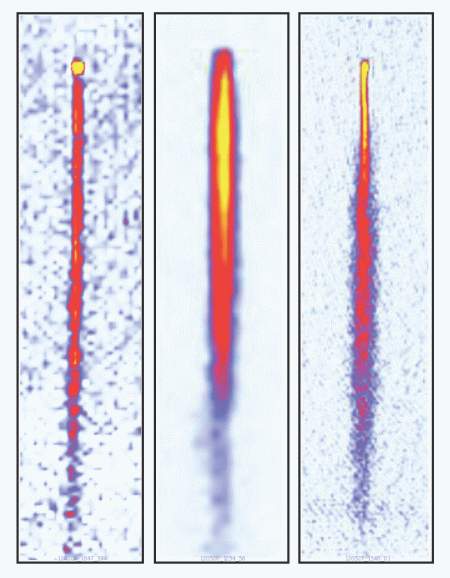
|
We present a novel, ultra-bright atom laser and an ultra-cold thermal atom beam. Using rf-radiation we strongly couple the magnetic hyperfine levels of 87Rb atoms in a trapped Bose-Einstein condensate. The resulting time-dependent adiabatic potential forms a trap, which at low rf-frequencies opens just below the condensate and thus allows an extremely bright well-collimated atom laser beam to emerge. As opposed to traditional atom lasers based on weak coupling of the magnetic hyperfine levels, this technique allows us to outcouple atoms at an arbitrarily large rate. We achieve a flux of 4 x 107 atom s-1, a seven fold increase compared to the brightest atom lasers to date. Furthermore, we demonstrate by two orders of magnitude the coldest thermal atom beam (200 nK). |
-
Press comments about this article appeared in
-
New Scientist , Record-breaking atom laser to hunt quantum gravity, 29 March 2014, p. 17. -
phys.org , Scientists overcome fundamental atom laser limit to build brightest atom laser to date, 7 May 2014. - New Journal of Physics highlights of the year.
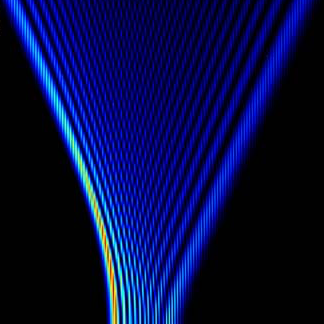
|
We study nondiffracting accelerating paraxial optical beams in periodic potentials, in both the linear and the nonlinear domains. In particular, we show that only a unique class of z-dependent lattices can support a true accelerating diffractionless beam. Accelerating lattice solitons, autofocusing beams and accelerating bullets in optical lattices are systematically examined. |
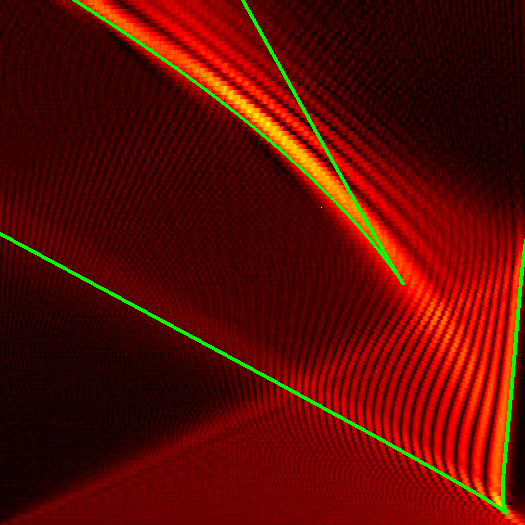
|
We study the dynamics of spatially accelerating beams impinging on refractive-index potentials. We concentrate our attention to the particular case of Airy-type optical waves that are reflected and transmitted by two generic classes of potentials. These are (a) localized potentials whose index contrast reduces to zero outside a specific region and (b) smooth-interface sigmoid-type potentials that take different constant values outside a bounded region. We find analytic expressions for the beam dynamics for particular types of potentials which are in excellent agreement with the numerical simulations. Our results show that, in general, the parabolic trajectory of the Airy wave is not maintained by the transmitted and reflected waves. An exception is made in the case of reflection from piecewise linear potentials, where the reflected wave follows a parabolic trajectory that is, in general, different from the incident. |
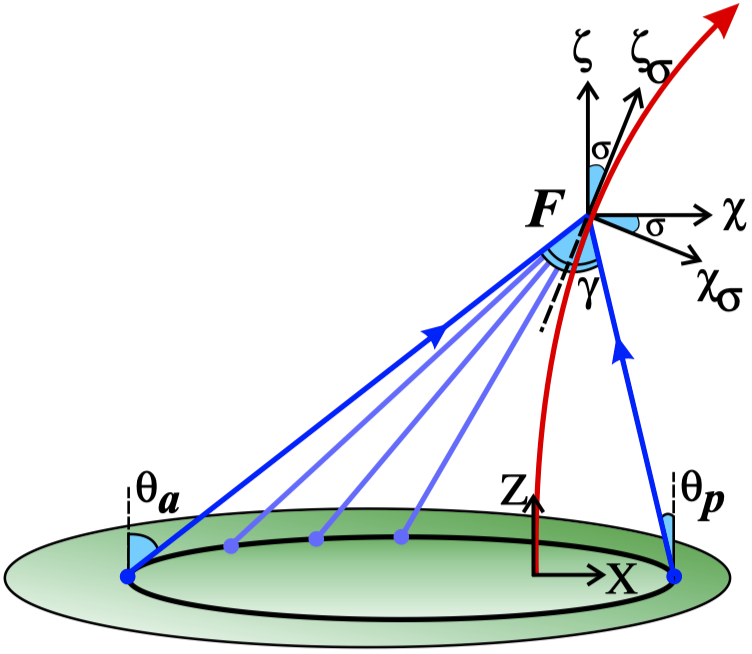
|
A class of nonparaxial accelerating optical waves is introduced. These are beams with a Bessel-like profile that are capable of shifting laterally along fairly arbitrary trajectories as the wave propagates in free space. The concept expands on our previous proposal of paraxial accelerating Bessel-like beams to include beams with subwavelength lobes and/or large trajectory angles. Such waves are produced when the phase at the input plane is engineered so that the interfering ray cones are made to focus along the prespecified path. When the angle of these cones is fixed, the beams possess a diffraction-free Bessel profile on planes that stay normal to their trajectory, which can be considered as a generalized definition of diffractionless propagation in the nonparaxial regime. The analytical procedure leading to these results is based on a ray-optics interpretation of Rayleigh-Sommerfeld diffraction and is presented in detail. The evolution of the proposed waves is demonstrated through a series of numerical examples and a variety of trajectories. |
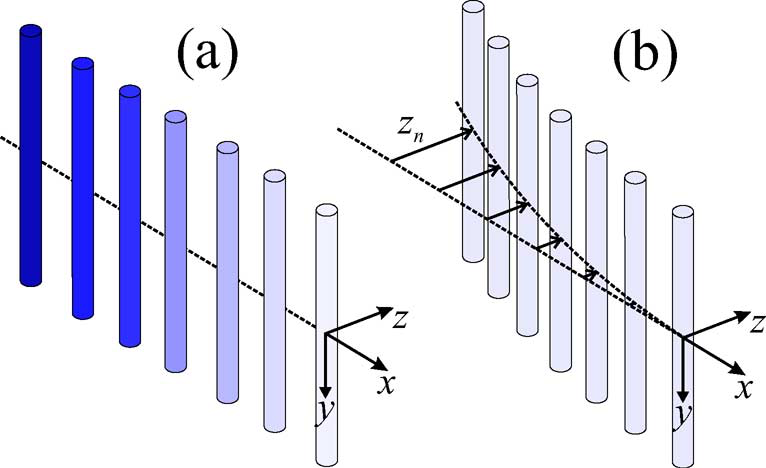
|
We introduce the concept of spatially accelerating (curved) beam waves in the Fresnel region of properly designed antenna arrays. These are transversely localized EM waves that propagate in free space in a diffraction-resisting manner, while at the same time laterally shifting their amplitude pattern along a curved trajectory. The proposed beams are the radiowave analogue of Airy and related accelerating optical waves, which, in contrast to their optical counterparts, are produced by the inter- ference of discrete radiating elements rather than by the evolution of a continuous wavefront. Two dyadic array configurations are proposed comprising 2D line antennas: linear phased arrays with a power-law phase variation and curved power-law arrays with in-phase radiating elements. Through analysis and numerical simulations, the formation of broadside accelerating beams with power-law trajectories is studied versus the array parameters. Furthermore, the abrupt autofocusing effect, that occurs when beams of this kind interfere with opposite acceleration, is investigated. The concept and the related antenna setups can be of use in radar and wireless communications applications. |
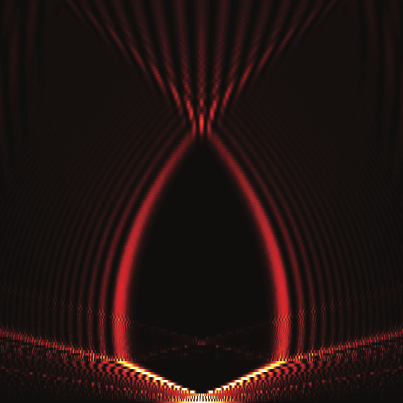
|
We predict that classes of coherent matter waves can self-accelerate without the presence of an external potential. Such Bose-Einstein condensates can follow arbitrary power-law trajectories and can also take the form of diffraction-free Airy waves. We also show that suitably engineered radially symmetric matter waves can abruptly autofocus in space and time. We suggest different schemes for the preparation of the condensate using laser beams to imprint an amplitude or a phase pattern onto the matter wave. Direct and Fourier space generation of such waves is discussed using continuous and binary masks as well as magnetic mirrors and lenses. We study the effect of interactions and find that independently of the type and strength of the nonlinearity, the dynamics are associated with the generation of accelerating matter waves. In the case of strong attractive interactions, the acceleration is increased while the radiation reorganizes itself in the form of soliton(s). |
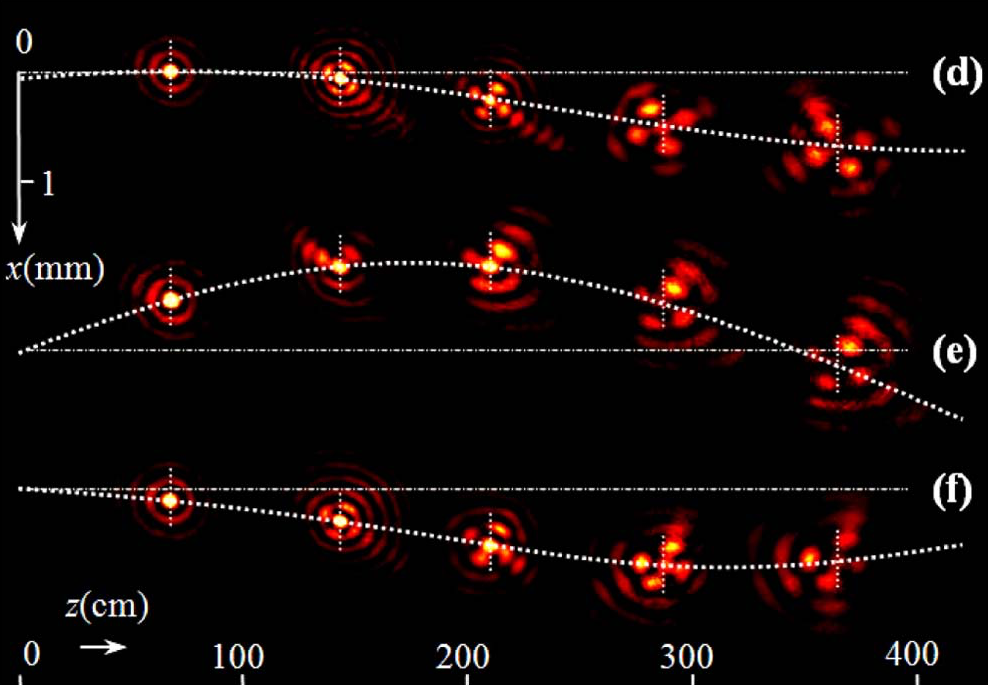
|
We experimentally demonstrate self-accelerating Bessel-like optical beams propagating along arbitrary trajectories in free space. With computer-generated holography, such beams are designed to follow different controllable trajectories while their main lobe transverse profiles remain nearly invariant and symmetric. Examples include parabolic, snake- like, hyperbolic, hyperbolic secant, and even three-dimensional spiraling trajectories. The self-healing property of such beams is also demonstrated. This new class of optical beams can be considered as a hybrid between accelerating and nonaccelerating nondiffracting beams that may find a variety of applications. |
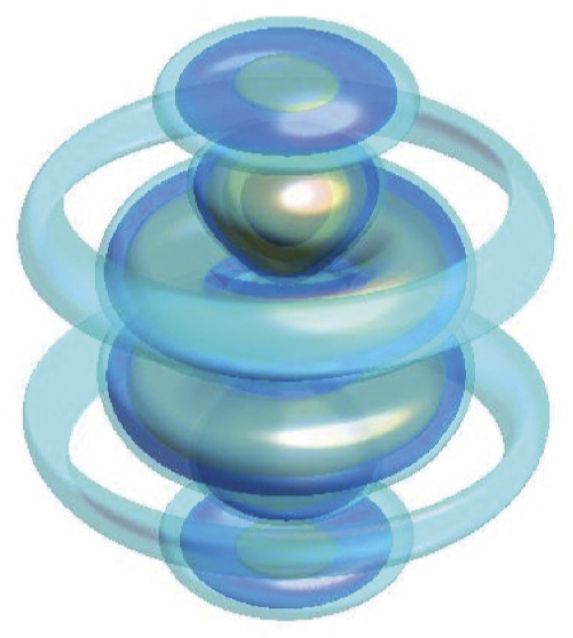
|
We introduce a class of propagation invariant spatiotemporal optical wave packets with spherical harmonic symmetries in their field configurations. The evolution of these light orbitals is considered theoretically in anomalously dispersive media, and their spinning dynamics are analyzed in terms of their corresponding energy flows. Similarly, localized waves generated via spherical superposition from Archimedean and Platonic solids in k-ω space are investigated in this work. |
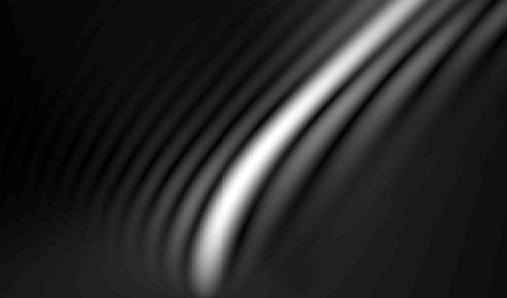
|
A method is proposed for generating Bessel-like optical beams with arbitrary trajectories in free space. The method involves phase-modulating an optical wavefront so that conical bundles of rays are formed whose apexes write a continuous focal curve with pre-specified shape. These ray cones have circular bases on the input plane; thus their interference results in a Bessel-like transverse field profile that propagates along the specified trajectory with a remarkably invariant main lobe. Such beams can be useful as hybrids between non-accelerating and accelerating optical waves that share diffraction-resisting and self-healing properties. |
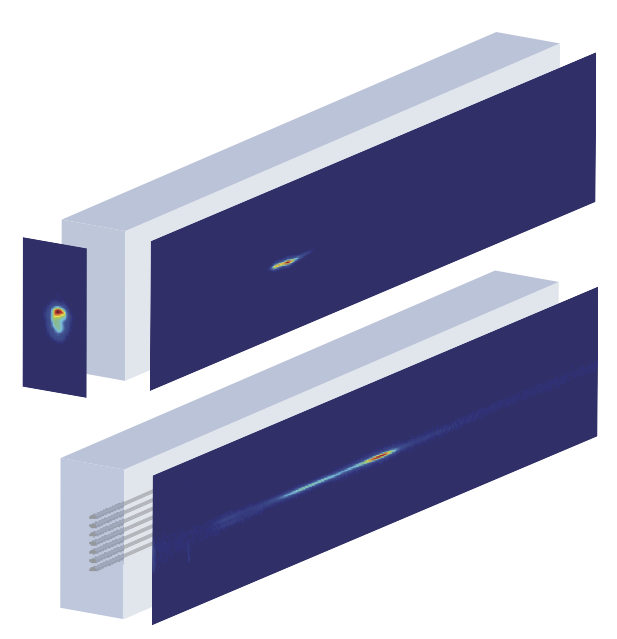
|
We demonstrate, for the first time, that photonic lattices support a new type of laser filaments, called lattice filaments (LF). The LF attributes (length, width, and intensity) can be tailored by both varying the photonic lattice properties and also dynamically through the interaction between filaments. This opens the way for extensive all-optical control of the nonlinear propagation of intense ultrafast wave packets. Our approach is generic and applicable to all transparent media, with potential strong impact on various photonic applications. |
A press comment about this article was published in
Physics
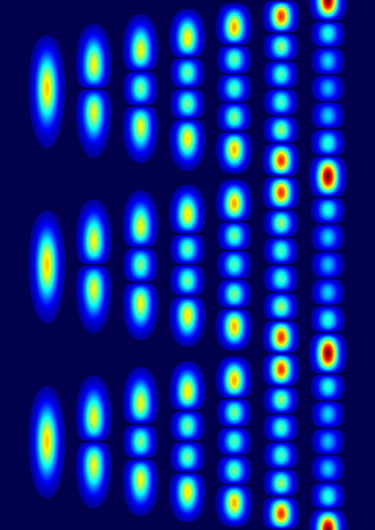
|
We propose a simple and algorithmic method for designing finite waveguide arrays capable of diffractionless transmission of arbitrary discrete beams by virtue of perfect revivals. Our approach utilises an inverse matrix eigenvalue theorem published by Hochstadt in 1974, which states that the Jacobi matrix, describing the system’s discrete evolution equations, is uniquely determined by its eigenvalues and the eigenvalues of its largest leading principal submatrix, as long as the two sets of eigenvalues interlace. It is further shown that, by arranging the two sets of eigenvalues symmetrically with respect to zero, the resulting Jacobi matrix has zero diagonal elements. Therefore, arrays with arbitrary revival lengths can be obtained by engineering only the inter-waveguide couplings. |
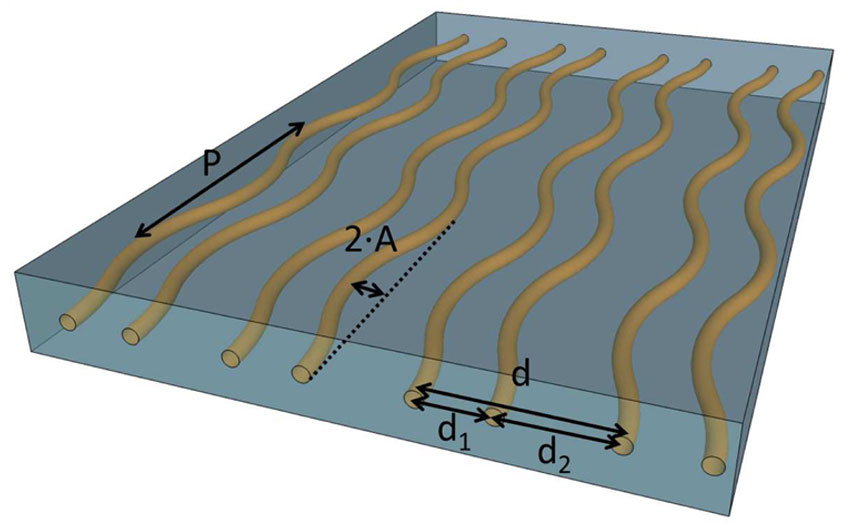
|
We demonstrate that light propagating in an appropriately designed lattice can exhibit dynamics akin to that expected from massless relativistic particles as governed by the one-dimensional Dirac equation. This is accomplished by employing a waveguide array with alternating positive and negative effective coupling coefficients, having a band structure with two intersecting minibands. Through this approach optical analogues of massless particle-antiparticle pairs are experimentally realized. One-dimensional conical diffraction is also observed for the first time in this work. |
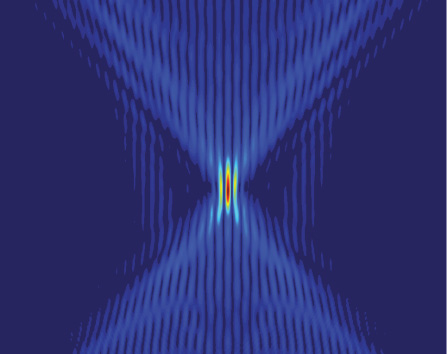
|
Band-specific design of curved light caustics and focusing in optical waveguide arrays is introduced. Going beyond the discrete, tight-binding model, which we examined recently, we show how the exact band structure and the associated diffraction relations of a periodic waveguide lattice can be exploited to phase-engineer caustics with predetermined convex trajectories or to achieve optimum aberration-free focal spots. We numerically demonstrate the formation of convex caustics involving the excitation of Floquet-Bloch modes within the first or the second band and even multiband caustics created by the simultaneous excitation of more than one band. Interference of caustics in abruptly autofocusing or collision scenarios are also examined. The experimental implementation of these ideas should be straightforward since the required input conditions involve phase-only modulation of otherwise simple optical wavefronts. By direct extension to more complex periodic lattices, possibilities open up for band-specific curving and focusing of light inside two-dimensional or even three-dimensional photonic crystals. |
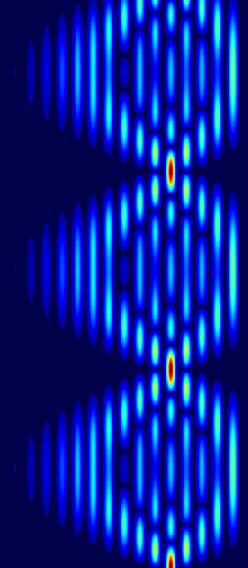
|
We predict that surface optical Bloch oscillations can exist in semi-infinite waveguide arrays with a linear index variation, if the array parameters close to the boundary are appropriately perturbed. The perturbation is such that the surface states obtain the Wannier-Stark ladder eigenvalues of the unperturbed infinite array. The number of waveguides, whose parameters need to be controlled, decreases with increasing ratio of index gradient over cou- pling. The configuration can find applications as a "matched" termination of waveguide arrays to eliminate the distortion of Bloch oscillations due to reflection on the boundaries. |
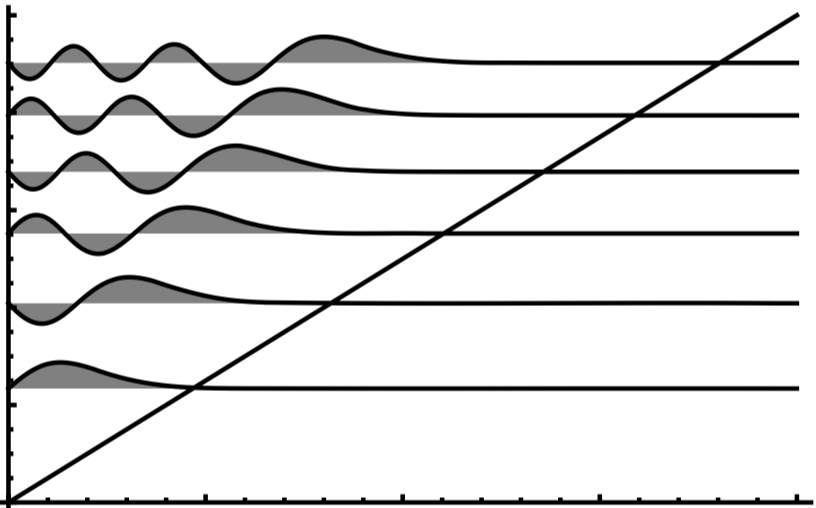
|
We study optical beams that are supported at the surface of a medium with a linear index potential and by a piecewise linear wedge-type potential. In the linear limit the modes are described by Airy functions. In the nonlinear regime we find families of solutions that bifurcate from the linear modes and study their stability for both self-focusing and self-defocusing Kerr nonlinearity. The total power of such nonlinear waves is finite without the need for apodization. |
Ranked No 7 in the Journal of the Optical Society of America A top downloads for June 2012.
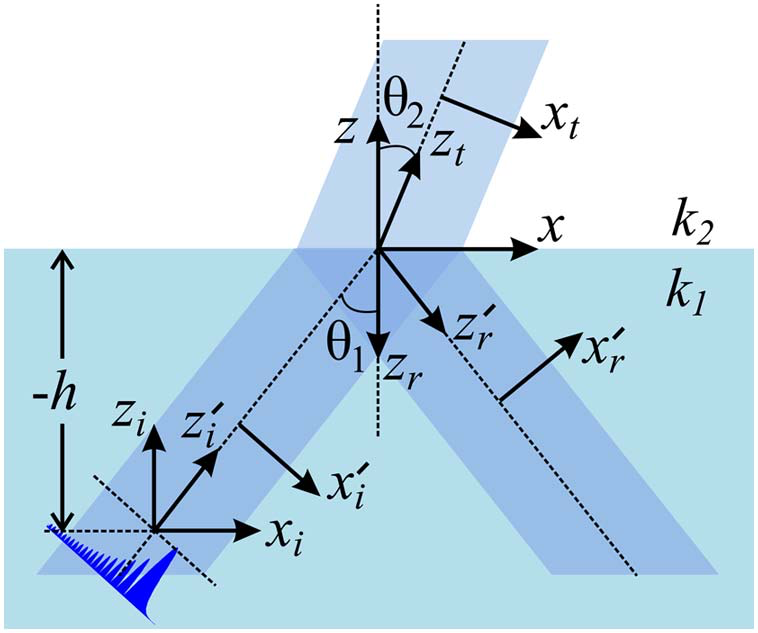
|
Reflection and refraction of a finite-power Airy beam at the interface between two dielectric media are investigated analytically and numerically. The formulation takes into account the paraxial nature of the optical beams to derive convenient field evolution equations in coordinate frames moving along Snell’s refraction and reflection axes. Through numerical simulations, the self-accelerating dynamics of the Airy-like refracted and reflected beams are observed. Of special interest are the cases of critical incidence at Brewster and total-internal-reflection (TIR) angles. In the former case, we find that the reflected beam achieves self-healing, despite the severe suppres- sion of a part of its spectrum, while, in the latter case, the beam remains nearly unaffected except for the Goos-Hänchen shift. The self-accelerating quality persists even if the beam is trapped by multiple TIRs inside a dielectric film. The grazing incidence of an Airy beam at the interface between two media with close refractive indices is also investigated, revealing that the interface can act as a filter depending on the beam scale and tilt. We finally consider reverse refraction and perfect imaging of an Airy beam into a left-handed medium. |
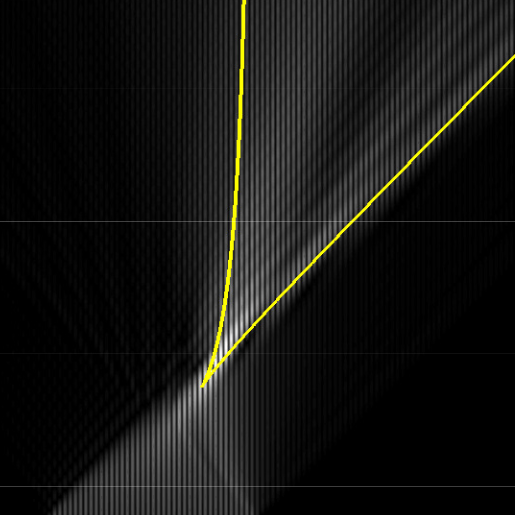
|
We study curved trajectory dynamics and design in discrete array settings. We find that beams with power law phases produce curved caustics associated with the fold and cusp type catastrophes. A parabolic phase produces a focus that suffers from spherical aberrations. More important, we find that by designing the initial phase or wavefront of the beam we can construct trajectories with pure power law caustics as well as aberration-free focusing of discrete waves. |
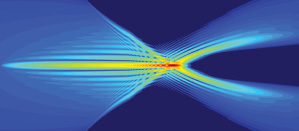
|
We propose a simple yet efficient method for generating abruptly autofocusing optical beams with arbitrary caustics. In addition, we introduce a family of abruptly autodefocusing beams whose maximum intensity suddenly decreases by orders of magnitude right after the target. The method relies on appropriately modulating the phase of a circularly symmetric optical wavefront, such as that of a Gaussian, and subsequently on Fourier-transforming it by means of a lens. If two such beams are superimposed in a Bessel-like standing wave pattern, then a complete mirror-symmetric, with respect to the focal plane, caustic surface of revolution is formed that can be used as an optical bottle. We also show how the same method can be used to produce accelerating 1D or 2D optical beams with arbitrary convex caustics. |
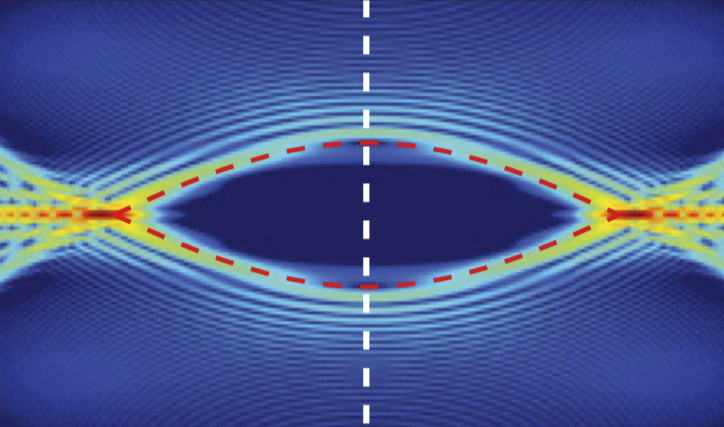
|
We demonstrate analytically and experimentally that a circular abruptly autofocusing (AAF) Airy beam can be generated by Fourier-transforming an appropriately apodized Bessel beam whose radial oscillations are chirped by a cubic phase term. Depending on the relation between the chirp rate and the focal distance of the Fourier- transforming lens, it is possible to generate AAF beams with one or two foci, the latter case leading to the formation of an elegant paraboloid optical bottle. |
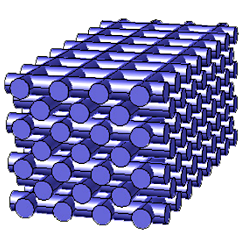
|
We report on our recent theoretical and experimental studies of three-dimensional (3D) photonic lattice structures which are established in a bulk nonlinear crystal by employing different optical induction techniques. These 3D photonic lattices bring about new opportunities for controlling the flow of light via coupling engineering originated from the lattice modulation along the beam propagation direction. By fine tuning the lattice parameters, we observe a host of unusual behaviors of beam propagation in such reconfigurable 3D lattices, including enhanced discrete diffraction, light tunneling inhibition-better known as coherent destruction of tunneling (CDT), anomalous diffraction, negative refraction, as well as CDT-based image transmission. In addition, we propose and demonstrate a new way of creating 3D ionic-type photonic lattices by controlled Talbot effect. |
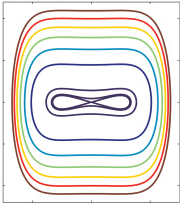
|
We analyze the 1D focusing nonlinear Schrödinger equation in a finite interval with homogeneous Dirichlet or Neumann boundary conditions. There are two main dynamics, the collapse which is very fast and a slow cascade of Fourier modes. For the cubic nonlinearity the calculations show no long-term energy exchange between Fourier modes as opposed to higher nonlinearities. This slow dynamics is explained by fairly simple amplitude equations for the resonant Fourier modes. Their solutions are well behaved so filtering high frequencies prevents collapse. Finally, these equations elucidate the unique role of the zero mode for the Neumann boundary conditions. |
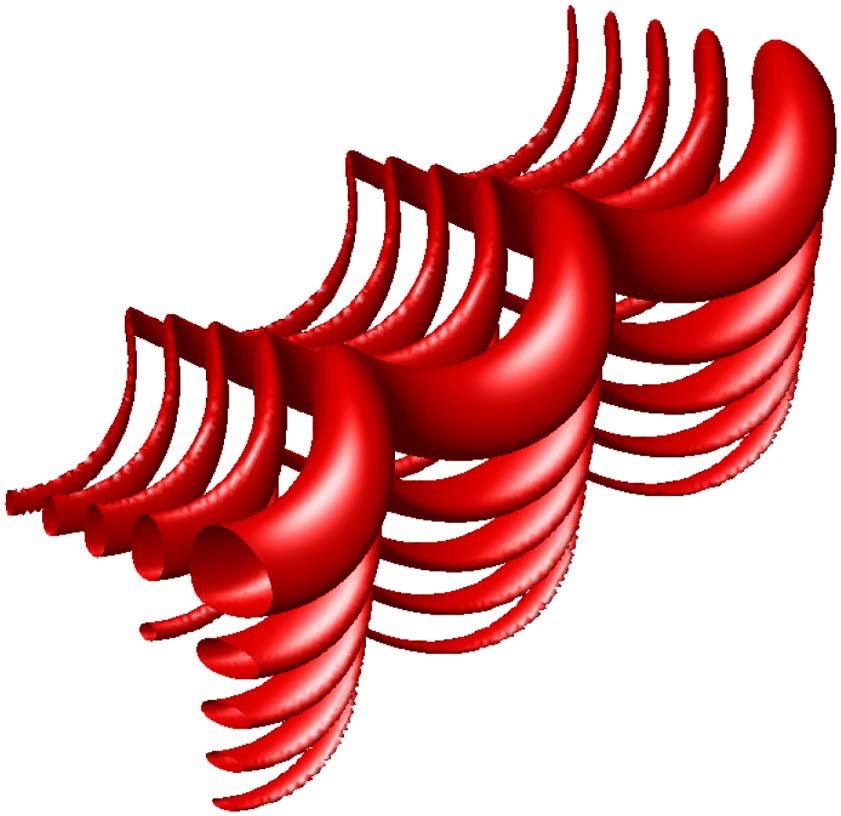
|
We study the propagation of Airy beams in transversely linear index potentials with a gradient that is dynamically changing along the propagation direction. We find exact solutions in the case of Airy and apodized (Gaussian and exponentially) Airy beams in 1 + 1 and 2 + 1 dimensions. More important, we find that the Airy beam can follow any predefined path, in which case the potential gradient is determined as a function of this path. |
This article was selected for the October 3, 2011 issue of the
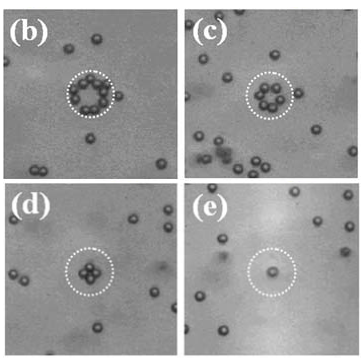
|
We observe optical trapping and manipulation of dielectric microparticles using autofocusing radially symmetric Airy beams. This is accomplished by exploiting either the inward or outward transverse acceleration associated with their chirped wavefronts. We experimentally demonstrate, for the first time to our knowledge, that such Airy beams morph into nondiffracting Bessel beams in their far-field. Furthermore, the ability of guiding and transporting microparticles along the primary rings of this class of beams is explored. |
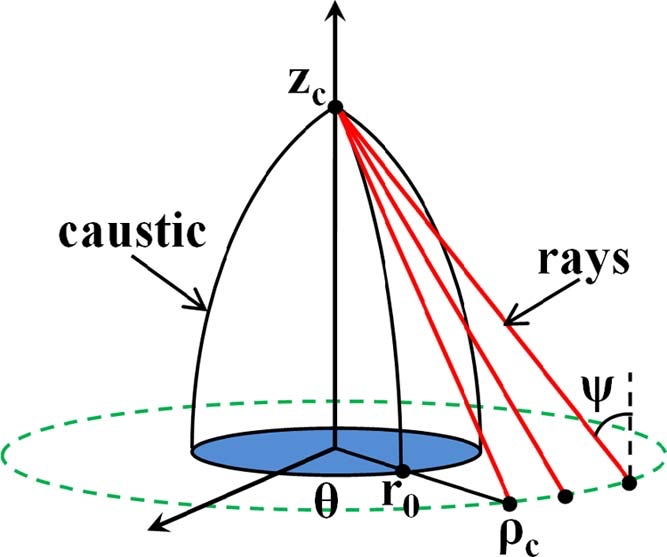
|
We introduce a new family of (2 + 1)D light beams with pre-engineered abruptly autofocusing properties. These beams have a circularly symmetric input profile that develops outward of a dark disk and oscillates radially as a sublinear-chirp signal, creating a series of concentric intensity rings with gradually decreasing width. The light rays involved in this process form a caustic surface of revolution that bends toward the beam axis at an acceleration rate that is determined by the radial chirp itself. The collapse of the caustic on the axis leads to a large intensity buildup right before the intended focus. This ray-optics interpretation provides valuable insight into the dynamics of abruptly autofocusing waves. |
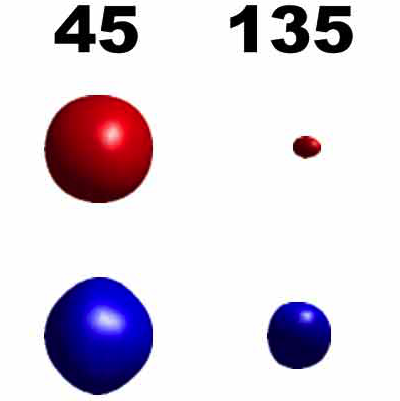
|
Femtosecond filamentation inside a periodic lattice in air is numerically shown to form intense dynamic bullets. The long propagation distance of the bullet structure is primarily attributed to the effect of the lattice that regulates the competition between linear and nonlinear spatiotemporal effects in the region of normal dispersion. |
Ranked No 2 in the Optics Letters top downloads for May 2011
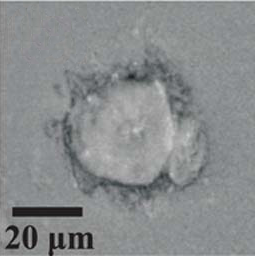
|
We report on the experimental observation of abruptly autofocusing waves. This interesting family of wave packets has been realized by using a radially symmetric Airy intensity distribution. As demonstrated in our experiments, these waves can exhibit unusual features, such as the ability to autofocus by following a parabolic trajectory toward their focus. |
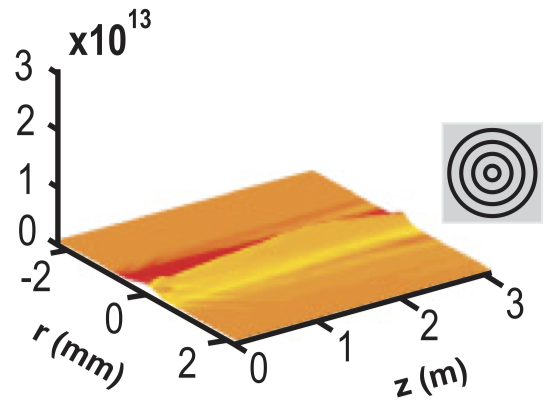
|
We show numerically that by using periodic lattices the filamentation of intense femtosecond laser pulses, otherwise a result of competing nonlinear effects, can be well controlled with respect to its properties. The diffraction induced by the lattice provides a regularizing mechanism to the nonlinear self-action effects involved in filamentation. We demonstrate a new propagation regime of intense lattice solitons bridging the field of spatial solitons with that of femtosecond laser filamentation. The effective filamentation control is expected to have an important impact on numerous applications. |
Ranked No 6 in the Optics Letters top downloads for December 2010.
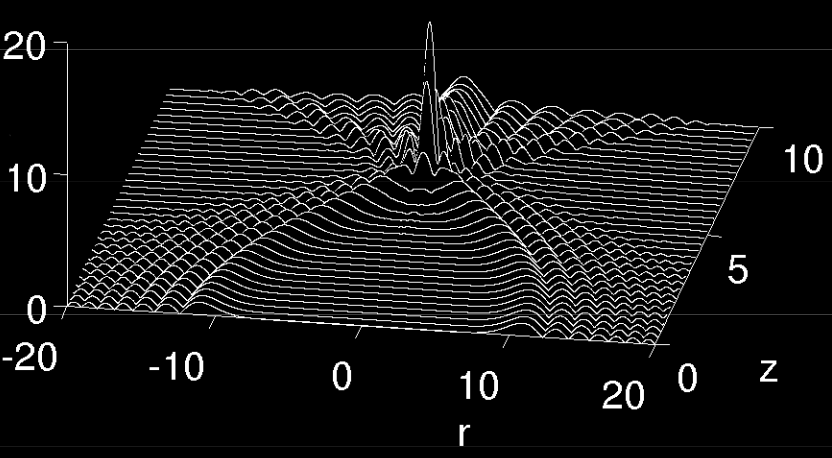
|
We introduce a new class of (2 + 1)D spatial and (3 + 1)D spatiotemporal waves that tend to autofocus in an abrupt fashion. While the maximum intensity of such a radial wave remains almost constant during propagation, it sud- denly increases by orders of magnitude right before its focal point. These waves can be generated through the use of radially symmetric Airy waves or by appropriately superimposing Airy wave packets. Possible applications of such abruptly focusing beams are also discussed. |
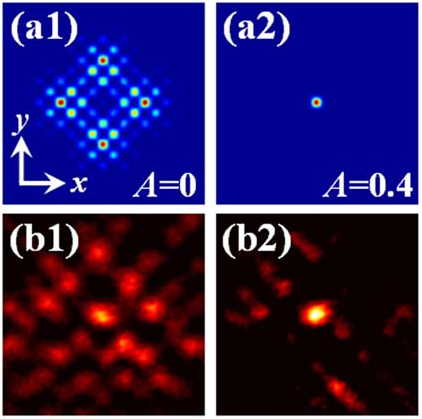
|
We demonstrate coherent destruction of tunneling (CDT) in optically induced three-dimensional photonic lattices. By fine-tuning the lattice modulation, we show unusual behavior of beam propagation, including light tunneling inhibition, anomalous diffraction, and negative refraction mediated by zero or negative coupling in the waveguide arrays. Image transmission based on CDT is also proposed and demonstrated. Our experimental results are in good agreement with our theoretical analyses. |
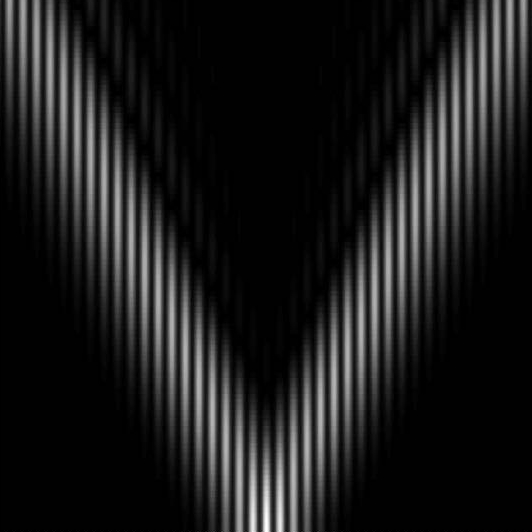
|
We introduce a waveguide array model with alternating positive and negative couplings between adjacent waveguides. Two different settings where such a model can be realized are identified as arrays of defects in Bragg gratings and arrays with propagation constants that periodically vary along the propagation direction. We analyze the properties of wave propagation in such waveguide arrays and find several interesting properties that have no counterpart in the case of arrays with constant couplings. These include the beam self-splitting, self-induced Talbot oscillations, symmetric evolution of Bloch oscillations, and new families of lattice solitons. |
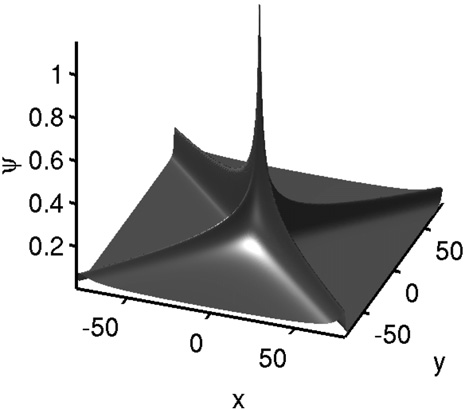
|
We find exact solutions of the two- and three-dimensional nonlinear Schrödinger equation with a supporting potential. We focus in the case where the diffraction operator is of the hyperbolic type and both the potential and the solution have the form of an X-wave. Following similar arguments, several additional families of exact solutions can also can be found irrespectively of the type of the diffraction operator (hyperbolic or elliptic) or the dimensionality of the problem. In particular we present two such examples: The one-dimensional nonlinear Schrödinger equation with a stationary and a "breathing" potential and the two-dimensional nonlinear Schrödinger with a Bessel potential. |
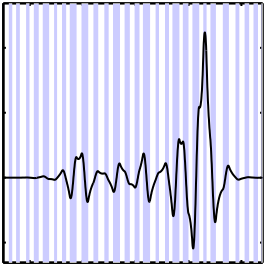
|
We analyze families of localized solutions of a nonlinear Schrödinger equation in the presence of a disordered potential modeling a waveguide array. A coupled mode theory approximation reveals that the families of disordered lattice solitons follow a cascade of Hopf-like bifurcations. Using a perturbation method, we analyze the origins of this bifurcation structure. We find that each family of solutions is characterized by a constant number of nodes. These predictions are in agreement with the numerical results of the nonlinear Schrödinger equation with a disordered potential. |
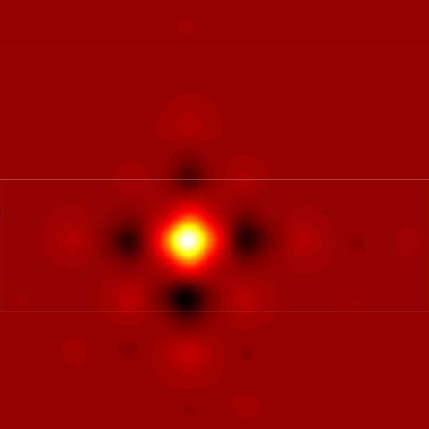
|
We demonstrate analytically and experimentally that a circular abruptly autofocusing (AAF) Airy beam can be generated by Fourier-transforming an appropriately apodized Bessel beam whose radial oscillations are chirped by a cubic phase term. Depending on the relation between the chirp rate and the focal distance of the Fourier-transforming lens, it is possible to generate AAF beams with one or two foci, the latter case leading to the formation of an elegant paraboloid optical bottle. |
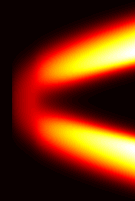
|
In this work, we consider the extension of linear eigenmodes of the harmonic oscillator potential into nonlinear states, for the case of two-component Gross-Pitaevskii equations with a parabolic potential, motivated by the context of two interacting hyperfine states of 87Rb in Bose-Einstein condensates. In particular, we establish that nonlinear continuations of various eigenmode combinations are possible and corroborate this analytical finding with numerical computations for the lowest few eigenmode combinations involving the ground state and the first two excited states. A multitude of nonlinear states can be constructed in this way, some of which spontaneously deform, as the interactions become stronger, into previously obtained nonlinear eigenstates. The Bogolyubov-de Gennes analysis of the excitations on top of such states illustrates that some of them may become unstable beyond a critical threshold (of the chemical potentials associated with the states), while others may be stable within the entire range of chemical potentials considered herein. When the modes are found to be unstable, their evolution is followed, leading to interesting dynamical effects such as spontaneous symmetry breaking or oscillatory growth. |
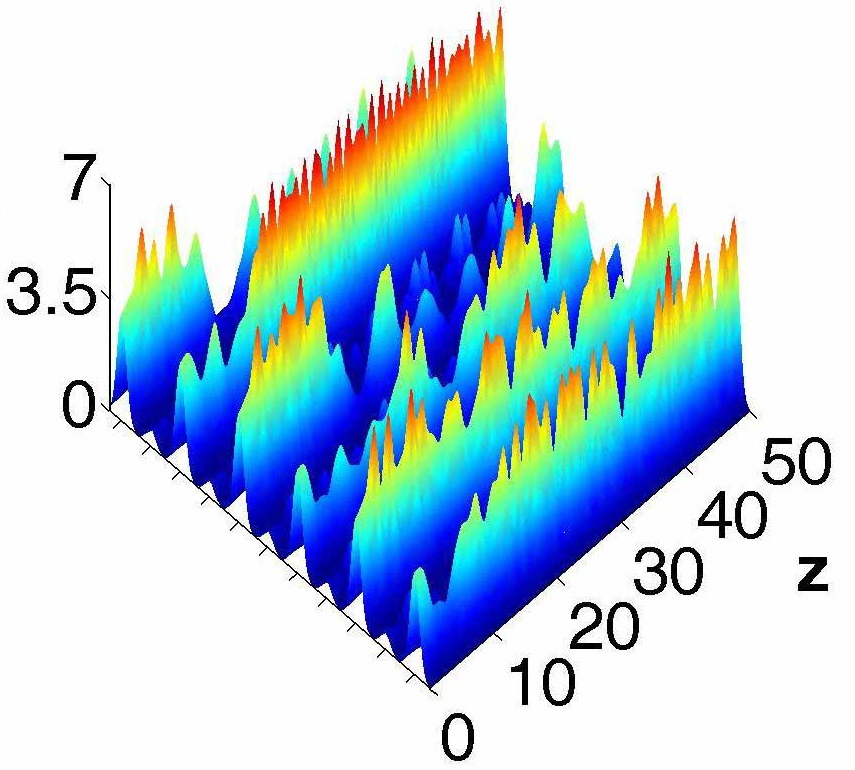
|
The system of coupled discrete equations describing a two-component superlattice with interlaced linear and nonlinear constituents is studied as a basis for investigating binary waveguide arrays, such as ribbed AlGaAs structures, among others. Compared to the single nonlinear lattice, the interlaced system exhibits an extra band-gap controlled by the, suitably chosen by design, relative detuning. In more general physics settings, this system represents a discretization scheme for the single-equation-based continuous models in media with transversely modulated linear and nonlinear properties. Continuous wave solutions and the associated modulational instability are fully analytically investigated and numerically tested for focusing and defocusing nonlinearity. The propagation dynamics and the stability of periodic modes are also analytically investigated for the case of zero Bloch momentum. In the band-gaps a variety of stable discrete solitary modes, dipole or otherwise, in-phase or of staggered type are found and discussed. |
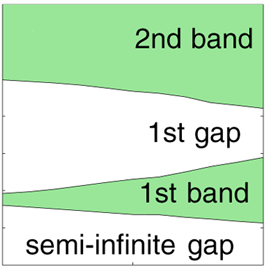
|
We study the properties of a nonlinear Schrödinger equation in the presence of a disordered potential modeling a waveguide array. We find that, for both signs of the nonlinearity, there is a large number of soliton families each one possessing different quantitative properties. However, all these families can be categorized to only a few classes with the same qualitative properties. Highly confined solitons exist in each waveguide of the lattice. In addition, solitons families originate from each Anderson mode. Resonant interactions between a soliton and an Anderson mode can take place, leading to broadening of the soliton profile. |
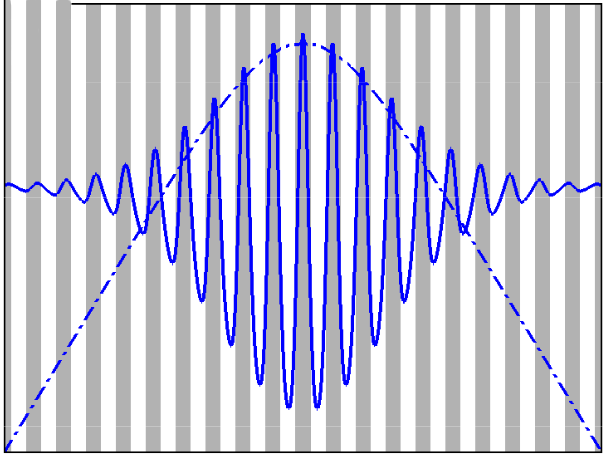
|
We study the properties of solitons in thermal nonlocal media having an infinite range of nonlocality with a periodic refractive index modulation. Such self-localized solutions exist for both signs of the nonlinearity and exhibit a host of features that have no counterpart in local or nonlocal media with finite range nonlocality. Perhaps the most intriguing property is that families of bright solitary pulses can exist inside the bands of the band structure. This property is attributed to the infinite range of nonlocality as well as to the boundary conditions applied to the system. Families of solitons bifurcating from higher-order band edges, otherwise unstable in local media, are found to be stable. |
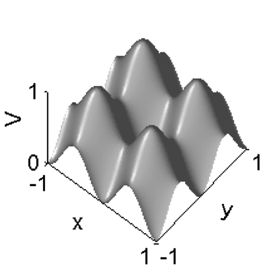
|
The profiles of narrow lattice solitons are calculated analytically using perturbation analysis. A stability analysis shows that solitons centred at a lattice (potential) maximum or saddle point are unstable, as they drift towards the nearest lattice minimum. This instability can, however, be so weak that the soliton is ‘mathematically unstable’ but ‘physically stable’. Stability of solitons centred at a lattice minimum depends on the dimension of the problem and on the nonlinearity. In the subcritical and supercritical cases, the lattice does not affect the stability, leaving the solitons stable and unstable, respectively. In contrast, in the critical case (e.g. a cubic nonlinearity in two transverse dimensions), the lattice stabilizes the (previously unstable) solitons. The stability in this case can be so weak, however, that the soliton is ‘mathematically stable’ but ‘physically unstable’. |
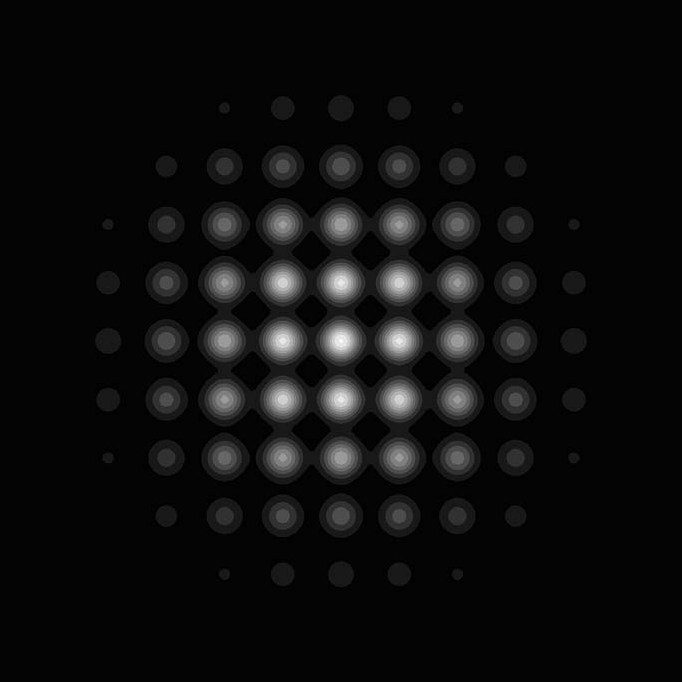
|
We study the two-dimensional discrete Ginzburg-Landau equation. In the linear limit, the dispersion and gain curves as well as the diffraction pattern are determined analytically. In the nonlinear case, families of two-dimensional discrete solitons are found numerically as well as approximately in the high-confinement limit. The instability dynamics are analyzed by direct simulations. |
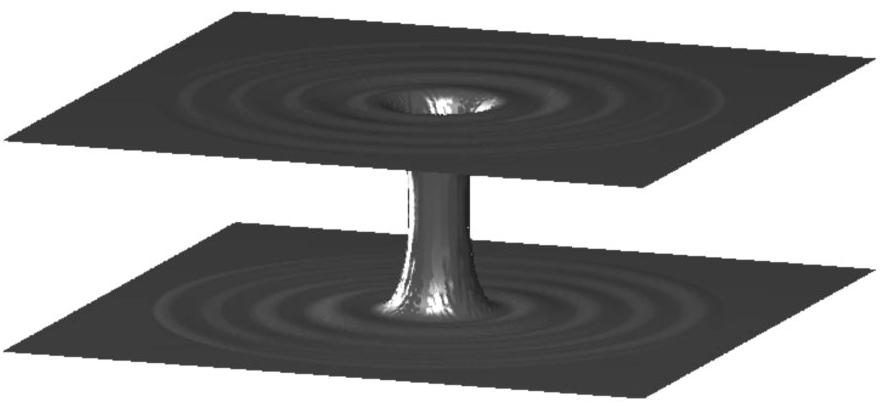
|
We demonstrate that families of vortex solitons are possible in a bidispersive three-dimensional nonlinear Schrödinger equation. These solutions can be considered as extensions of two-dimensional dark vortex solitons which, along the third dimension, remain localized due to the interplay between dispersion and nonlinearity. Such vortex solitons can be observed in optical media with normal dispersion, normal diffraction, and defocusing nonlinearity. |
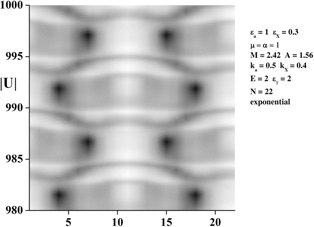
|
A circular array of optical waveguides collectively coupled with a central core is investigated. Nonlinear losses, both linear and nonlinear coupling as well as energy transfer between neighboring array elements and between the array and the core are allowed. The concept is ideal for the design of high power stable amplifiers as well as of all-optical data processing devices in optical communications. The existence of stable steady-state continuous wave modes as well as of localized solitary and breathing type modes is demonstrated. These properties render the proposed system functionally rich, far more controllable than a planar one and easier to stabilize. |
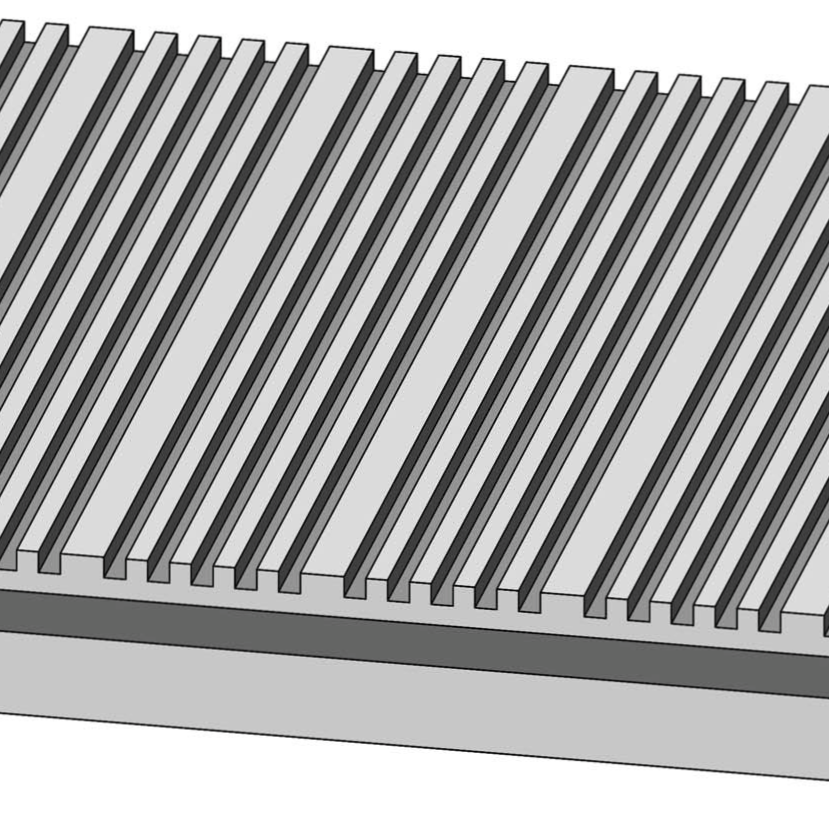
|
A new type of waveguide lattice that relies on the effect of bandgap guidance, rather than total internal reflection, in the regions between the waveguide defects is proposed. Two different setting, for low index and high index defects are suggested. We analyze the linear bandgap and diffraction properties of such lattices. In the nonlinear regime the Kerr effect can counteract diffraction leading to the formation of gap lattice solitons. Interestingly enough, in the case of low index defects, stable soliton solutions are localized in the low index areas. This finding challenges the widely accepted idea that stable solitons can be sustained in high refractive index regions. In addition, in the case of high index defects, the coupling coefficient can become negative. Physical settings where the linear and nonlinear properties for bandgap lattices can be experimentally realized are presented. |
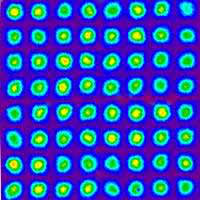
|
The recent proposal of optical induction for producing nonlinear photonic lattices has revolutionized the study of nonlinear waves in waveguide arrays. In particular, it enabled the first observation of (2+1) dimensional lattice solitons, which were the first 2D solitons observed in any nonlinear periodic system in nature. Since then, progress has been rapid, with many fundamental discoveries made within the past two years. Here, we review our theoretical and experimental contributions to this effort. |
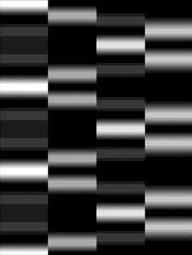
|
We show that perfect and fractional revivals are possible in finite waveguide arrays with engineered parameters. We consider potential applications of waveguide lattices utilizing operations such as multi-couplers and multi-beam-splitters. Specific examples of finite lattices with four and five elements that allow such operations are presented. |
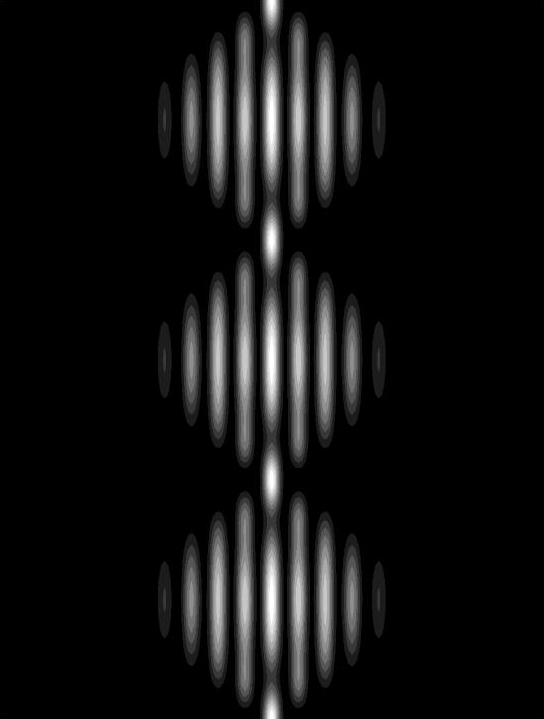
|
We show that Bloch oscillations are possible in dissipative optical waveguide lattices with a linearly varying propagation constant. These oscillations occur in spite of the fact that the Bloch wave packet experiences coupling gain and (or) loss. Experimentally, this process can be observed in different settings, such as in laser arrays and lattices of semiconductor optical amplifiers. In addition, we demonstrate that these systems can suppress instabilities arising from preferential mode noise growth. |
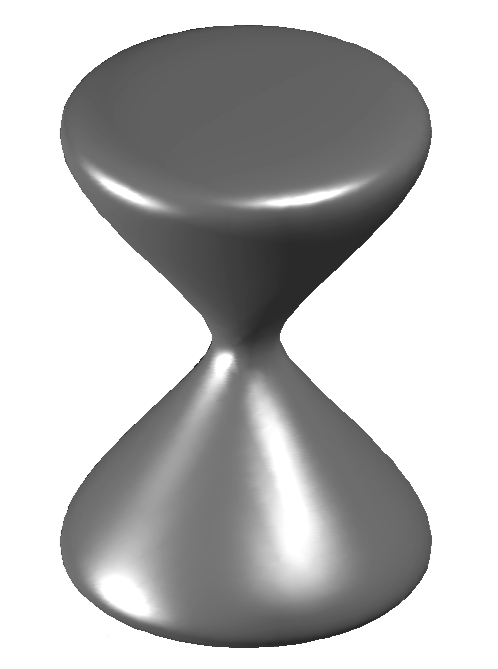
|
We show that new families of two- and three-dimensional nondiffracting Bessel X waves are possible in linear bidispersive optical systems. These X waves can be observed in both bulk and waveguide configurations as well as in photonic crystal lattices that simultaneously exhibit normal and anomalous dispersive-diffractive properties in different spatial or spatiotemporal coordinates. |
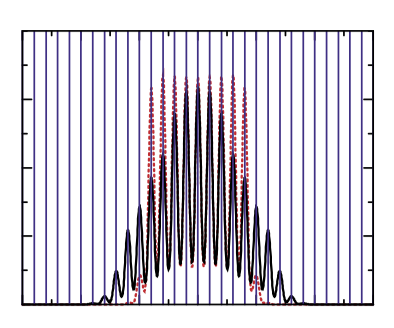
|
We predict the existence of random phase solitons in nonlinear periodic lattices. These solitons exist when the nonlinear response time is much longer than the characteristic time of random phase fluctuations. The intensity profiles, power spectra, and statistical (coherence) properties of these stationary waves conform to the periodicity of the lattice. The general phenomenon of such solitons is analyzed in the context of nonlinear photonic lattices. |
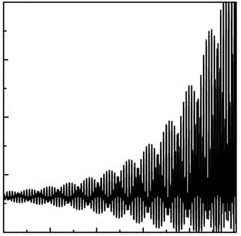
|
A circular array of optical waveguides collectively coupled with a central core is investigated. Both linear and nonlinear coupling as well as energy transfer within the array elements and with the core are allowed making thus the model ideal for the design of high power stable amplifiers as well as of all-optical data processing devices in optical communications. The existence of stable steady- state continuous wave modes as well as of breathing modes is demonstrated. These properties render the proposed system functionally rich, far more controllable than a planar one and easier to stabilize. |

|
We demonstrate that both the linear (diffraction) and the nonlinear dynamics of two-dimensional waveguide arrays are considerably more complex and versatile than their one-dimensional counterparts. The discrete diffraction properties of these arrays can be effectively altered, depending on the propagation Bloch k-vector within the first Brillouin zone of the lattice. In general, this diffraction behavior is anisotropic and therefore permits the existence of a new class of discrete elliptic solitons in the nonlinear regime. |
This article was selected for the December 1, 2003 issue of the
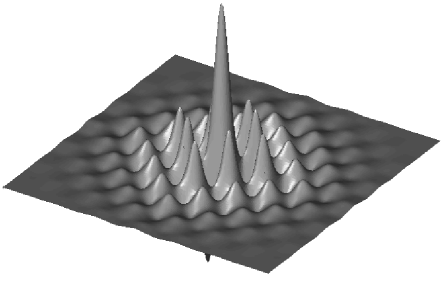
|
We study various families of two-dimensional discrete or lattice solitons, and show that they are possible only when their power level exceeds a critical threshold. In addition, we show that gap-lattice solitons exist only when the lattice possesses a complete 2D band gap. Our results suggest that these conditions are universally valid, irrespective of the nature of the nonlinearity or the specific structure of the index lattice. The analysis explains fundamental aspects of behavior of two-dimensional discrete solitons that have been very recently observed in photosensitive optical crystals. |
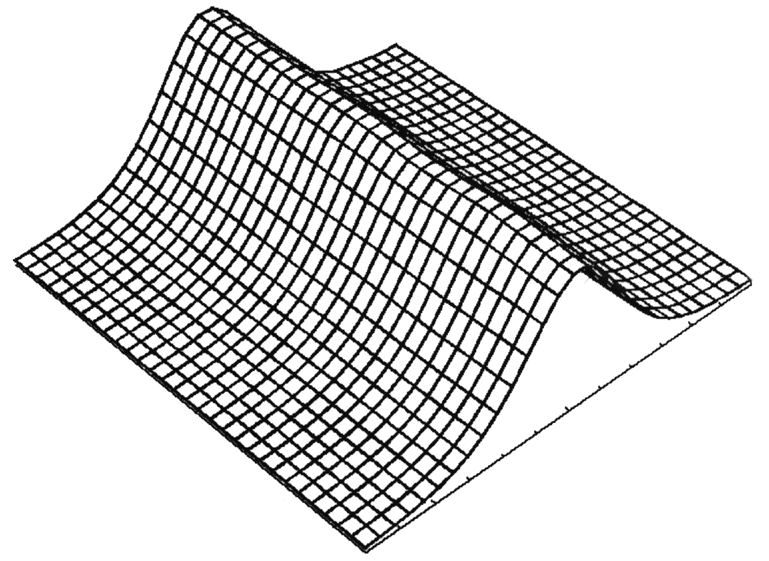
|
Optical spatial solitons made from incoherent white light were experimentally observed in 1997 by Mitchell and Segev [Nature (London) 387, 880 (1997)]. We present what is believed to be the first theory describing these solitons and find the characteristic features of their spatiotemporal coherence properties and their temporal power spectrum. |
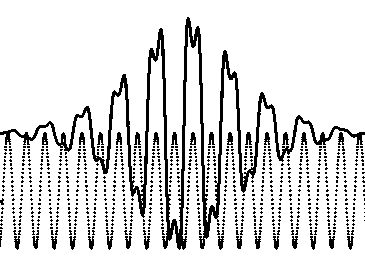
|
We systematically study the properties of lattice solitons in Bose-Einstein condensates with either attractive or repulsive atom interactions. This is done, by exactly solving the mean-field Gross-Pitaevskii equation in the presence of a periodic potential. We find new families of lattice soliton solutions that are characterized by the position of the energy eigenvalue within the associated band structure. These include lattice solitons in con- densates with either attractive or repulsive atom interactions that exist in finite or semi-infinite gaps, as well as nonlinear modes that exhibit atomic population cutoffs. |
This article was selected for the December 1, 2003 issue of the
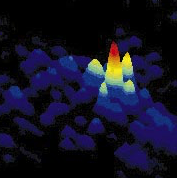
|
We demonstrate analytically and experimentally that a circular abruptly autofocusing (AAF) Airy beam can be generated by Fourier-transforming an appropriately apodized Bessel beam whose radial oscillations are chirped by a cubic phase term. Depending on the relation between the chirp rate and the focal distance of the Fourier-transforming lens, it is possible to generate AAF beams with one or two foci, the latter case leading to the formation of an elegant paraboloid optical bottle. |
Press comments about this article appeared in:
Physics Today, column Physics Update, "Two-dimensional lattice solitons", p. 9, April 2003.
Optics and Photonics News, column Scatterings, p. 10, "A first for solitons", July 2003.
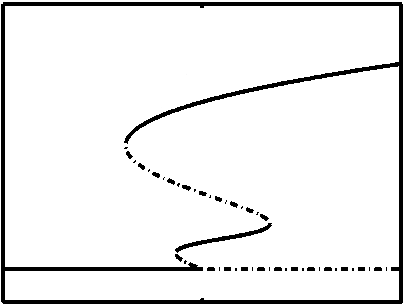
|
We demonstrate that discrete solitons are possible in Ginzburg-Landau lattices. As a result of discreteness, we find that this system exhibits a host of features that have no counterpart whatsoever in either the continuous limit or in other conservative discrete models. |
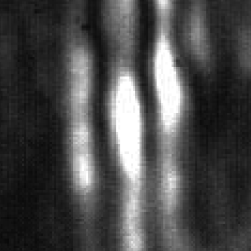
|
We report the first experimental observation of discrete solitons in an array of optically induced waveguides. The waveguide lattice is induced in real time by illuminating a photorefractive crystal with a pair of interfering plane waves. We demonstrate two types of bright discrete solitons: in-phase self- localized states and the staggered (π-out-of-phase) soliton family. This experiment is the first observation of bright staggered solitons in any physical system. Our scheme paves the way for reconfigurable focusing and defocusing photonic lattices where low-power (mW) discrete solitons can be thoroughly investigated. |
(Optics in 2002: Special issue of Optics & Photonics News that highlights the most exciting peer-reviewed optics research to have emerged over the past 12 months).
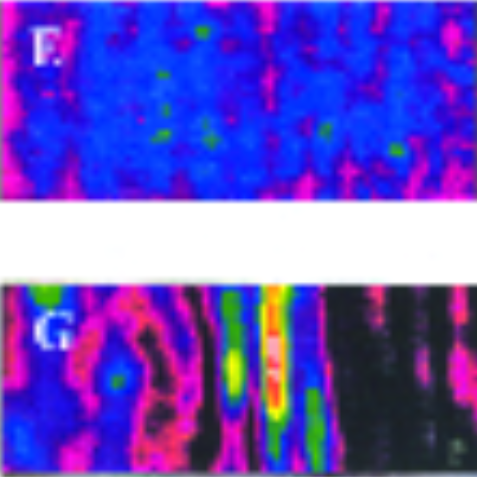
|
We review our theoretical and experimental results about solitons in optically induced photonic lattices. |
This article was selected for the October 14, 2002 issue of the
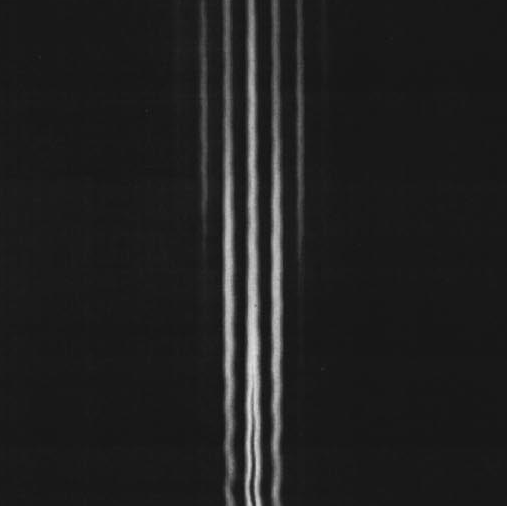
|
We demonstrate that optical discrete solitons are possible in appropriately oriented biased photorefractive crystals. This can be accomplished in optically induced periodic waveguide lattices that are created via plane- wave interference. Our method paves the way towards the observation of entirely new families of discrete solitons. These include, for example, discrete solitons in two-dimensional self-focusing and defocusing lattices of different group symmetries, incoherently coupled vector discrete solitons, discrete soliton states in optical diatomic chains, as well as their associated collision properties and interactions. We also present results concerning transport anomalies of discrete solitons that depend on their initial momentum within the Brillouin zone. |
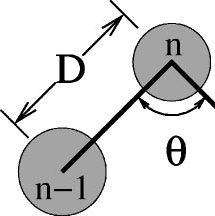
|
We show that the discrete diffraction properties of a nonlinear optical zigzag waveguide array can be significantly modified, by exploiting the topological arrangement of the lattice itself. This introduces extended interactions (beyond nearest neighbors), which, in turn, affect the lattice dispersion relation within the Brillouin zone. As a result of this band alteration, we demonstrate that altogether different families of discrete soliton solutions are possible, which are stable over a wide range of parameters. In the regime where instabilities occur, all scenarios are considered in detail. By appropriately engineering the geometrical configuration of the array we find both standing and traveling diffraction-free beams. Our method opens opportunities for diffraction management that can be employed to generate low-power spatial discrete optical solitons. |
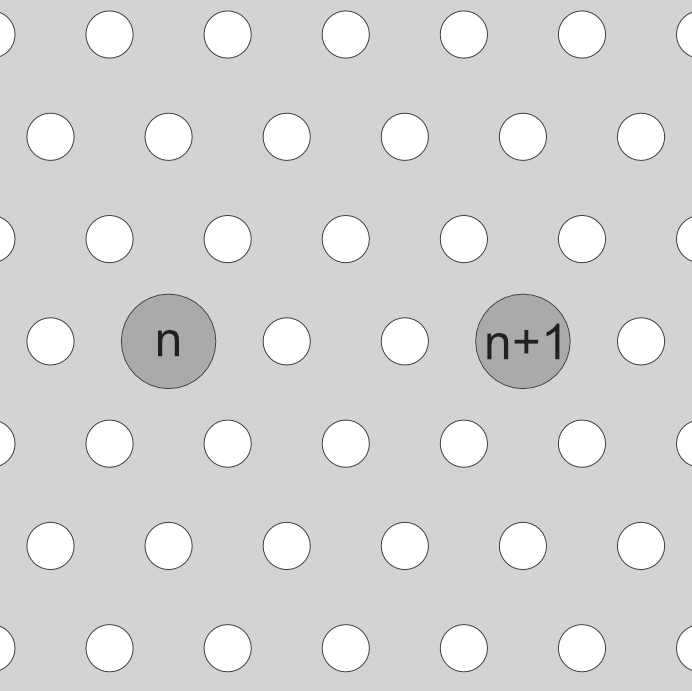
|
We demonstrate that spatiotemporal discrete solitons are possible in nonlinear photonic crystal structures. Analysis indicates that these states can propagate undistorted along a series of coupled resonators or defects by balancing of the effects of discrete lattice dispersion with material nonlinearity. In principle, these self-localized entities are capable of exhibiting very low velocities, depending on the coupling coefficient among successive microcavities. This class of solitons can follow any preassigned path in a three-dimensional environment. |
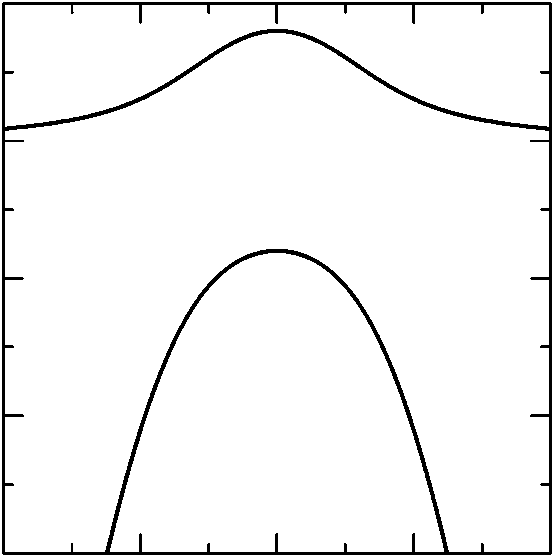
|
We study the stability and interactions of chirped solitary pulses in a system of nonlinearly coupled cubic Ginzburg-Landau (CGL) equations with a group-velocity mismatch between them, where each CGL equation is stabilized by linearly coupling it to an additional linear dissipative equation. In the context of nonlinear fiber optics, the model describes transmission and collisions of pulses at different wavelengths in a dual-core fiber, in which the active core is furnished with bandwidth-limited gain, while the other, passive (lossy) one is necessary for stabilization of the solitary pulses. Complete and incomplete collisions of pulses in two channels in the cases of anomalous and normal dispersion in the active core are analyzed by means of perturbation theory and direct numerical simulations. It is demonstrated that the model may readily support fully stable pulses whose collisions are quasielastic, provided that the group-velocity difference between the two channels exceeds a critical value. In the case of quasielastic collisions, the temporal shift of pulses, predicted by the analytical approach, is in semiquantitative agreement with direct numerical results in the case of anomalous dispersion (in the opposite case, the perturbation theory does not apply). We also consider a simultaneous collision between pulses in three channels, concluding that this collision remains quasielastic, and the pulses remain completely stable. Thus, the model may be a starting point for the design of a stabilized wavelength-division-multiplexed transmission system. |
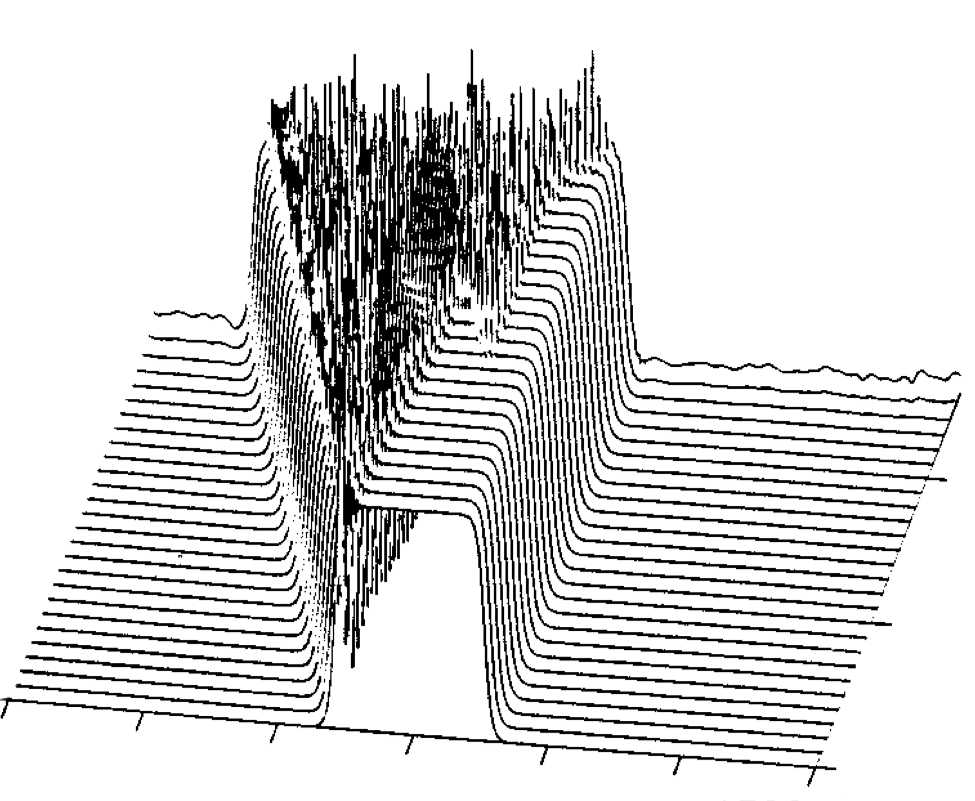
|
The propagation of nonreturn-to-zero pulses, composed by a superposition of two exact shock-wave solutions of a complex-cubic Ginzburg-Landau equation linearly coupled to a linear nondispersive equation, is studied in detail. The model describes the distributed (average) propagation in a dual-core erbium-doped fiber-amplifier-supported optical-fiber system where stabilization is achieved by means of short segments of an extra lossy core that is parallel and coupled to the main one. The linear-stability analysis of the two asymptotic states of the shock wave in combination with direct numerical simulations provide necessary conditions for optimal propagation of the nonreturn-to-zero pulse. The enhancement of the propagation distance by at least an order of magnitude, under a suitable choice of the parameters, establishes the beneficial role of the passive channel. |
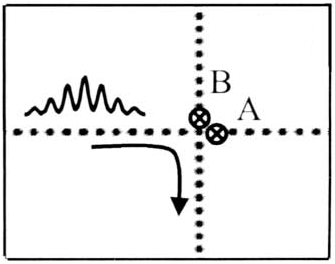
|
The performance of switching junctions in two-dimensional discrete-soliton networks is analyzed theoretically by coupled-mode theory. Our analysis can be used for the design of routing junctions with specified operational characteristics. Appropriately engineering the intersection site can further improve the switching efficiency of these junctions. |
(Optics in 2001: Special issue of Optics & Photonics News that highlights the most exciting peer-reviewed optics research to have emerged over the past 12 months).
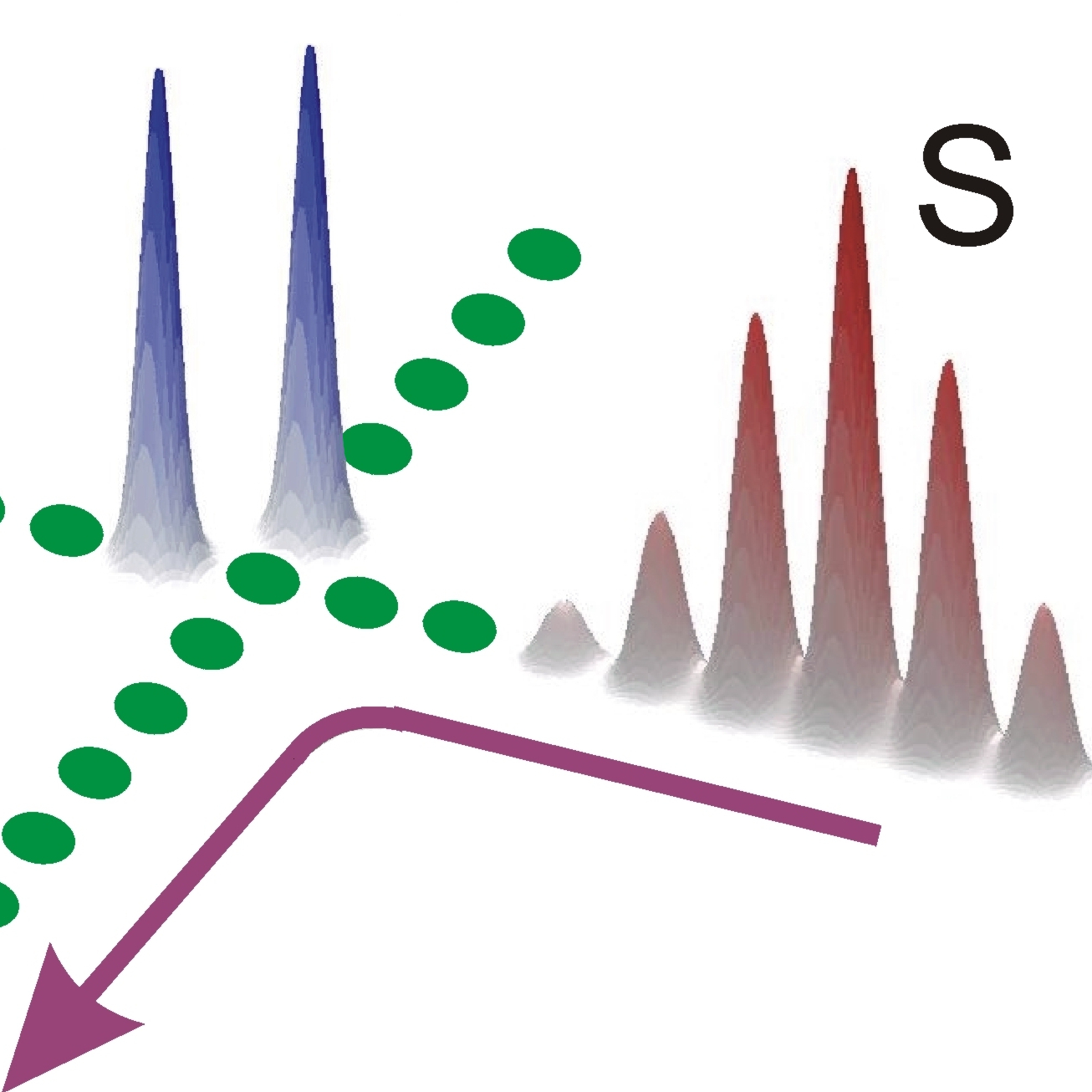
|
We review our work on switching and routing discrete solitons in two-dimensional nonlinear waveguide array networks. |
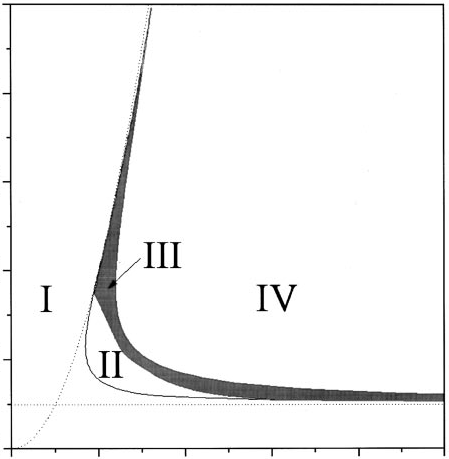
|
The existence and stability of exact continuous-wave and dark-soliton solutions to a system consisting of the cubic complex Ginzburg-Landau (CGL) equation linearly coupled with a linear dissipative equation is studied. We demonstrate the existence of vast regions in the system’s parameter space associated with stable dark-soliton solutions, having the form of the Nozaki-Bekki envelope holes, in contrast to the case of the conven- tional CGL equation, where they are unstable. In the case when the dark soliton is unstable, two different types of instability are identified. The proposed stabilized model may be realized in terms of a dual-core nonlinear optical fiber, with one core active and one passive. |
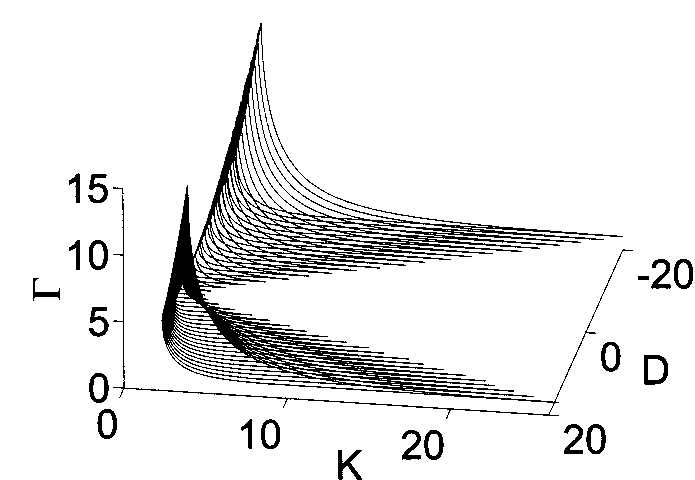
|
We study in detail stability of exact chirped solitary-pulse solutions in a model in which stabilization of the pulses is achieved by means of short segments of an extra lossy core, which is parallel coupled to the main one. We demonstrate that, in the model's three-dimensional parameter space, there is a vast region in which the pulses are fully stable, for both signs of the group-velocity dispersion. These results open the way to a stable transmission of solitary optical pulses in the normal-dispersion region and thus to an essential expansion of the bandwidth offered by the nonlinear optical fibers for telecommunications in the return-to-zero regime. In the cases in which the pulses are unstable, we study the development of the instability, which may end by either blowing up or decaying to zero. In the case when the pulses are stable, we also simulate interactions between them, concluding that they always eventually merge into one pulse. |
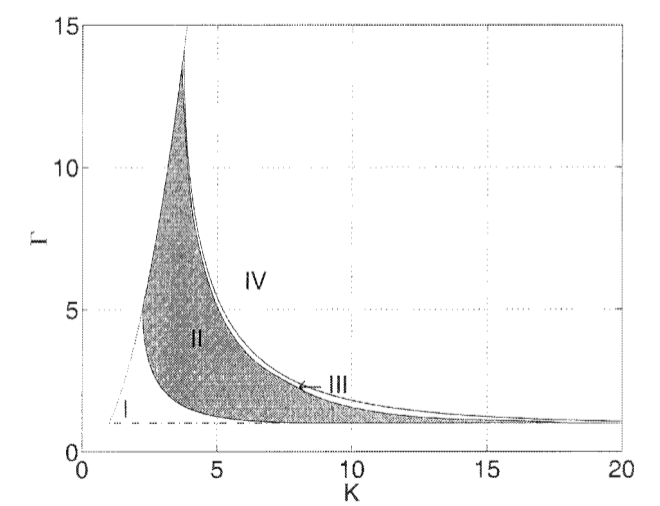
|
We study in detail stability of exact chirped solitary-pulse solutions in a model of a filtered nonlinear optical fiber, in which stabilization of the pulses is achieved by means of an extra lossy core, parallel-coupled to the main one. We demonstrate that, in the model's three-dimensional parameter space, there is a vast region where the pulses are fully stable, for both signs of the group-velocity dispersion. These results open way to a stable transmission of optical solitons in the normal-dispersion region and, thus, to an essential expansion of the bandwidth offered by the nonlinear optical fibers for telecommunications. In the cases when the pulses are unstable, we study the development of the instability, which may end up by either a blowup or decay to zero. |
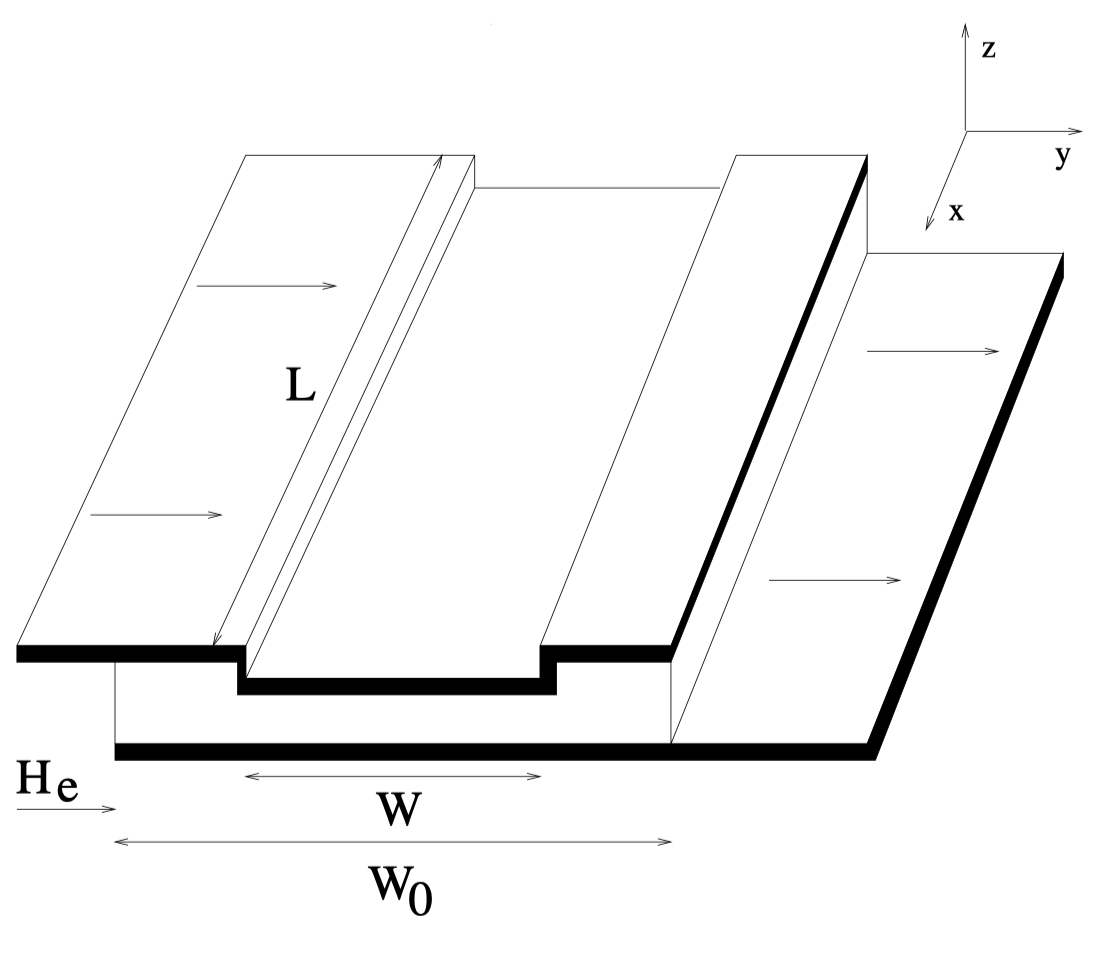
|
We developed an efficient hybrid mode expansion method to study the maximum tunneling current as a function of the external magnetic field for a 2D large area lateral window junction. We consider the inhomogeneity in the critical current density, which is taken a piecewise constant. The natural modes of the expansion in y, are the linearized eigen-modes around a static solution which satisfies the 1D sine-Gordon equation with the critical current variation in y, and the boundary conditions determined by the overlap component of the bias current, which can be inline or overlap like. The magnetic field along with the inline component of the bias current enters as a boundary condition on the modal amplitudes. We obtain fast convergent results and for a ratio of idle to window widths of w0/w = 4 (in units of λJ), only two modes are needed. A simple scaling is obtained for the maximum tunneling current as we vary the idle region width. We also present the linear electromagnetic waveguide modes taking into account the variation normal to the waveguide of the critical current and the capacitance. |
